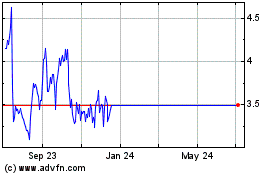0001404644FALSE00014046442024-03-182024-03-18
UNITED STATES
SECURITIES AND EXCHANGE COMMISSION
Washington, D.C. 20549
FORM 8-K
CURRENT REPORT
Pursuant to Section 13 OR 15(d) of The Securities Exchange Act of 1934
Date of Report (date of earliest event reported): May 10, 2024
Neurogene Inc.
(Exact name of registrant as specified in its charter)
| | | | | | | | |
Delaware | 001-36327 | 98-0542593 |
(State or other jurisdiction of incorporation or organization) | (Commission File Number) | (I.R.S. Employer Identification No.) |
535 W 24th Street, 5th Floor
New York, NY 10011
(Address of principal executive offices, including zip code)
Registrant's telephone number, including area code: (877) 237-5020
N/A
(Former Name or Former Address, if Changed Since Last Report)
Check the appropriate box below if the Form 8-K filing is intended to simultaneously satisfy the filing obligation of the registrant under any of the following provisions (see General Instruction A.2. below):
☐ Written communications pursuant to Rule 425 under the Securities Act (17 CFR 230.425)
☐ Soliciting material pursuant to Rule 14a-12 under the Exchange Act (17 CFR 240.14a-12)
☐ Pre-commencement communications pursuant to Rule 14d-2(b) under the Exchange Act (17 CFR 240.14d-2(b))
☐ Pre-commencement communications pursuant to Rule 13e-4(c) under the Exchange Act (17 CFR 240.13e-4(c))
Securities registered pursuant to Section 12(b) of the Act:
| | | | | | | | | | | | | | |
| Title of each class | | Trading Symbol(s) | | Name of each exchange on which registered |
| Common Stock, $0.000001 par value | | NGNE | | The Nasdaq Global Market |
Indicate by check mark whether the registrant is an emerging growth company as defined in Rule 405 of the Securities Act of 1933 (§230.405 of this chapter) or Rule 12b-2 of the Securities Exchange Act of 1934 (§240.12b-2 of this chapter).
Emerging growth company ☐
If an emerging growth company, indicate by check mark if the registrant has elected not to use the extended transition period for complying with any new or revised financial accounting standards provided pursuant to Section 13(a) of the Exchange Act. o
| | | | | |
| Item 2.02 | Results of Operations and Financial Condition |
On May 10, 2024, Neurogene Inc. (the “Company”) issued a press release announcing financial results for the quarter ended March 31, 2024. A copy of the press release announcing such results is attached as Exhibit 99.1 to this Current Report on Form 8-K. Also on May 10, 2024, the Company posted an updated corporate presentation on its website. A copy of the corporate presentation is furnished as Exhibit 99.2 to this Current Report on Form 8-K.
The information in this Item 2.02 and Exhibits 99.1 and 99.2 attached hereto are being furnished and shall not be deemed “filed” for the purposes of Section 18 of the Securities Exchange Act of 1934, as amended (the "Exchange Act"), or otherwise subject to the liabilities of that section, nor shall such information or Exhibits 99.1 and 99.2 be deemed incorporated by reference into any filing under the Exchange Act or the Securities Act of 1933, as amended, except as expressly set forth by specific reference to such filing.
| | | | | |
| Item 9.01 | Financial Statements and Exhibits. |
(d) Exhibits
| | | | | | | | |
| | |
Exhibit Number | | Description |
| |
| 99.1 | | |
| 99.2 | | |
| 104 | | Cover Page Interactive Data File (embedded within the Inline XBRL document) |
SIGNATURE
Pursuant to the requirements of the Securities Exchange Act of 1934, as amended, the registrant has duly caused this report to be signed on its behalf by the undersigned thereunto duly authorized.
| | | | | | | | |
| NEUROGENE INC. |
| | |
| Date: May 10, 2024 | By: | /s/ Christine Mikail |
| | Name: Christine Mikail |
| | Title: President, Chief Financial Officer |
Neurogene Reports First Quarter 2024 Financial Results and Highlights Recent Updates
Presented favorable safety data from Phase 1/2 NGN-401 gene therapy trial for Rett syndrome at ASGCT Annual Meeting
Received Australian HREC approval for NGN-401 trial
Remains on track to provide interim NGN-401 efficacy data from Cohort 1 in 4Q:24
Strong balance sheet with cash runway into 2H:26
NEW YORK – May 10, 2024 – Neurogene Inc. (Nasdaq: NGNE), a clinical-stage company founded to bring life-changing genetic medicines to patients and families affected by rare neurological diseases, today announced first quarter 2024 financial results and highlighted recent corporate updates.
“We have made substantial progress in our NGN-401 Rett syndrome gene therapy program since the beginning of the year, including dosing the third patient, expanding the trial to include additional patients and a high-dose cohort, and the recent clearance to conduct the trial in Australia,” said Rachel McMinn, Ph.D., Founder and Chief Executive Officer of Neurogene. “We were pleased to present data at the ASGCT Annual Meeting earlier this week, which continued to show that NGN-401 has been generally well-tolerated. We remain on track to release interim efficacy data from the low-dose cohort in the fourth quarter of 2024.”
Continued Dr. McMinn, “The NGN-401 data support our strategy to expand into additional disease areas that could benefit from gene therapy with transgene regulation, and we continue to plan to advance an additional product candidate into the clinic in 2025. We remain in a strong financial position with cash runway into the second half of 2026.”
First Quarter 2024 and Recent Highlights, and Anticipated Milestones
Phase 1/2 Trial of NGN-401 Gene Therapy for Treatment of Rett Syndrome
•Presented favorable safety data from the first three pediatric patients in low-dose Cohort 1 at the American Society of Gene and Cell Therapy (ASGCT) Annual Meeting:
oNGN-401 has been generally well-tolerated in all three patients with approximately nine, six and three months of follow-up, respectively
oAll treatment-related adverse events (AEs) have been mild/Grade 1, and all laboratory value changes are known risks of AAV administration and asymptomatic
oNo signs or symptoms of MeCP2 overexpression toxicity reported in any patient, including Patient 1 who is nine months post-dosing and has a mild MECP2 variant predicted to result in residual MeCP2 expression
oNo treatment-emergent or intracerebroventricular procedure-related serious AEs
•Announced today acknowledgment from the Australian Therapeutic Goods Administration and approval from the Human Research Ethics Committee (HREC) to conduct the Phase1/2 clinical trial for NGN-401in Australia, the third region in which the trial is cleared
•Continues to expect to report interim clinical data, including efficacy data from Cohort 1, in the fourth quarter of 2024; additional interim data, including from Cohort 2, are expected in the second half of 2025
•Previously expanded the trial to include a high-dose Cohort 2 and more patients in low-dose Cohort 1; these updates are expected to generate a more complete data package and inform the design of a future NGN-401 registrational study
•Remains on track to complete enrollment in Cohort 1 in the second half of 2024 and to begin enrollment in Cohort 2 in the second quarter of 2024
Phase 1/2 Trial of NGN-101 Gene Therapy for Treatment of CLN5 Batten Disease
•Continuing enrollment in high-dose Cohort 3, and plans to provide interim clinical data and a regulatory update in the second half of 2024; given the rarity of the disease, U.S. Food and Drug Administration alignment on a streamlined registrational pathway will be critical for continued investment in the program
Additional Corporate Updates
•Advancing early-stage portfolio, and anticipates an additional product candidate using transgene regulation technology to enter the clinic in 2025
Upcoming Events
•5th Annual Goldman Sachs Global Healthcare Conference: Management will provide a corporate presentation on June 12 at 1:20 p.m. ET and participate in 1x1 meetings
•2024 IRSF (International Rett Syndrome Foundation) Rett Syndrome Scientific Meeting: Presentation of safety data from the Phase 1/2 NGN-401 gene therapy trial for Rett syndrome on June 18-19, 2024
First Quarter 2024 Financial Results
•Cash Position: Cash, cash equivalents and investments as of March 31, 2024 were $169.5 million. Cash outflows pertaining to the transaction with Neoleukin Therapeutics, including the offering costs associated with the pre-closing financing, were $9.6 million for the quarter ended March 31, 2024. The Company expects current cash, cash equivalents and marketable securities to fund operations into the second half of 2026.
•Research & Development (“R&D”) Expenses: R&D expenses were $13.5 million for the three months ended March 31, 2024 compared to $10.3 million for the three months ended March 31, 2023. The increase in R&D expenses was primarily driven by an increase in NGN-401 clinical trial costs, increased preclinical costs related to our early discovery programs, and an increase in compensation and benefits expenses due to an increase in R&D headcount.
•General & Administrative (“G&A”) Expenses: G&A expenses were $5.2 million for the three months ended March 31, 2024 compared to $2.8 million for the three months ended March 31, 2023. The increase in G&A expenses was primarily driven by an increase in compensation and benefits expenses due to an increase in G&A headcount, professional fees, insurance, information technology and other costs associated with becoming a public company.
•Net Loss: Net loss was $16.9 million for the three months ended March 31, 2024 compared to net loss of $12.3 million for the three months ended March 31, 2023.
About Neurogene
The mission of Neurogene is to treat devastating neurological diseases to improve the lives of patients and families impacted by these rare diseases. Neurogene is developing novel approaches and treatments to address the limitations of conventional gene therapy in central nervous system disorders. This includes selecting a delivery approach to maximize distribution to target tissues and designing
products to maximize potency and purity for an optimized efficacy and safety profile. The Company’s novel and proprietary EXACT transgene regulation platform technology allows for the delivery of therapeutic levels while limiting transgene toxicity associated with conventional gene therapy. Neurogene has constructed a state-of-the-art gene therapy manufacturing facility in Houston, Texas. CGMP production of NGN-401 was conducted in this facility and will support pivotal clinical development activities. For more information, visit www.neurogene.com.
Cautionary Note Regarding Forward-Looking Statements
Statements in this press release which are not historical in nature are intended to be, and hereby are identified as, forward-looking statements within the meaning of the Private Securities Litigation Reform Act of 1995. These statements may discuss goals, intentions and expectations as to future plans, trends, events, results of operations or financial condition, or otherwise, based on current expectations and beliefs of the management of Neurogene, as well as assumptions made by, and information currently available to, management of Neurogene, including, but not limited to, statements regarding: the therapeutic potential and utility, efficacy and clinical benefits of NGN-401 and NGN-101; the safety and tolerability profile of NGN-401; trial designs, clinical development plans and timing for each of NGN-401 and NGN-101, including anticipated timing of enrollment in and clinical trial results from the Company’s NGN-401 Phase 1/2 trial for Rett syndrome or NGN-101 Phase 1/2 trial for CLN5 Batten Disease; initiation of new clinical sites for NGN-401 in Australia; expected interactions with the FDA regarding NGN-101; nomination of additional preclinical product candidates; and our expected cash resources and liquidity. Forward-looking statements generally include statements that are predictive in nature and depend upon or refer to future events or conditions, and include words such as “may,” “will,” “should,” “would,” “expect,” “anticipate,” “plan,” “likely,” “believe,” “estimate,” “project,” “intend,” “on track,” and other similar expressions or the negative or plural of these words, or other similar expressions that are predictions or indicate future events or prospects, although not all forward-looking statements contain these words. Forward-looking statements are based on current beliefs and assumptions that are subject to risks, uncertainties and assumptions that are difficult to predict with regard to timing, extent, likelihood, and degree of occurrence, which could cause actual results to differ materially from anticipated results and many of which are outside of Neurogene’s control. Such risks, uncertainties and assumptions include, among other things: risks related to the timing and success of enrolling patients in the expanded cohort of our Phase 1/2 clinical trial of NGN-401 for the treatment of Rett syndrome; the expected timing and results of dosing of patients in our clinical trials, including NGN-401 and NGN-101; the potential that we may not be able to expand our Phase 1/2 clinical trial of NGN-401 for the treatment of Rett syndrome into Australia based on a variety of factors, including but not limited to any decisions of regulatory authorities, costs of expanding the trial in Australia, the availability of suitable clinical test sites, and the ability to enroll patients in Australia, or other reasons; the potential for negative impacts to patients resulting from using a higher dose of NGN-401 in Cohort 2 of the Phase 1/2 clinical trial for the treatment of Rett syndrome; the risk that we may not be able to report our data on the predicted timeline; risks related to our ability to obtain regulatory approval for, and ultimately commercialize, our product candidates, including NGN-401; and other risks and uncertainties identified under the heading "Risk Factors" included in our Annual Report on Form 10-K for the year ended December 31, 2023, filed with the Securities and Exchange Commission (“SEC”) on March 18, 2024, or our Quarterly Report on Form 10-Q for the quarter ended March 31, 2024, and other filings that the Company has made and may make with the SEC in the future. Nothing in this communication should be regarded as a representation by any person that the forward-looking statements set forth herein will be achieved or that the contemplated results of any such forward-looking statements will be achieved. Forward-looking statements in this communication speak only as of the day they are made and are
qualified in their entirety by reference to the cautionary statements herein. Except as required by applicable law, Neurogene undertakes no obligation to revise or update any forward-looking statement, or to make any other forward-looking statements, whether as a result of new information, future events or otherwise.
This communication contains hyperlinks to information that is not deemed to be incorporated by reference into this communication.
- Financial Tables Follow -
| | | | | | | | | | | |
| Neurogene Inc. |
| Condensed Consolidated Balance Sheets |
(In Thousands of U.S. dollars) |
| | | |
| March 31, 2024 | | December 31, 2023 |
| Assets | | | |
| Cash and cash equivalents | $ 150,140 | | $ 148,210 |
| Other current assets | 24,001 | | 52,138 |
| Non-current assets | 21,209 | | 22,225 |
| Total assets | $ 195,350 | | $ 222,573 |
| Liabilities | | | |
| Current liabilities | $ 11,818 | | $ 22,973 |
| Non-current liabilities | 12,755 | | 13,576 |
| Total liabilities | 24,573 | | 36,549 |
| Stockholders' equity | 170,777 | | 186,024 |
| Total liabilities and stockholders' equity | $ 195,350 | | $ 222,573 |
| | | | | | | | | | | |
| Neurogene Inc. |
| Condensed Consolidated Statements of Operations |
| (In thousands of U.S. dollars, except share information) |
| | | |
| Three Months Ended |
| March 31, |
| 2024 | | 2023 |
| Operating expenses: | | | |
| Research and development | $ 13,541 | | $ 10,283 |
| General and administrative | 5,238 | | 2,752 |
| Total operating expenses | 18,779 | | 13,035 |
| Loss from operations | (18,779) | | (13,035) |
| Other income, net | 1,858 | | 772 |
| Net loss | $ (16,921) | | $ (12,263) |
| | | |
Per share information: (1) | | | |
| Net loss per share, basic and diluted | $ (1.00) | | $ (28.28) |
| Weighted-average shares of common stock outstanding, basic and diluted |
16,903,735 | |
433,623 |
| | | |
(1) For the three months ended March 31, 2023, net loss per share information is presented for the Company’s then outstanding Class A common stock. For the three months ended March 31, 2024, net loss per share information is presented for the Company’s common stock. See Note 1, Reverse Merger and Pre-Closing Financing and Note 3, Net Loss Per Share Attributable to Common Stockholders, for additional information. |
Company Contact:
Cara Mayfield
Vice President, Corporate Affairs
cara.mayfield@neurogene.com
Investor Contact:
Melissa Forst
Argot Partners
Neurogene@argotpartners.com
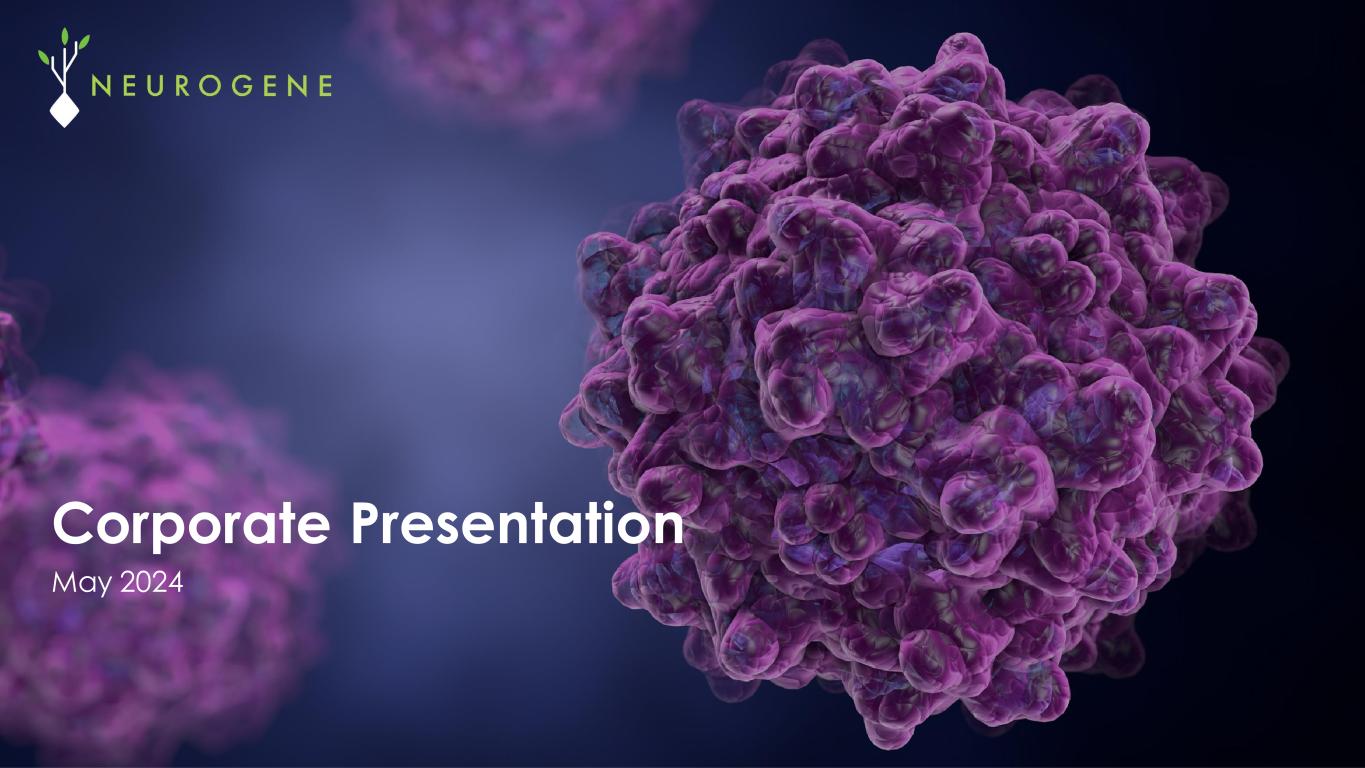
May 2024 Corporate Presentation
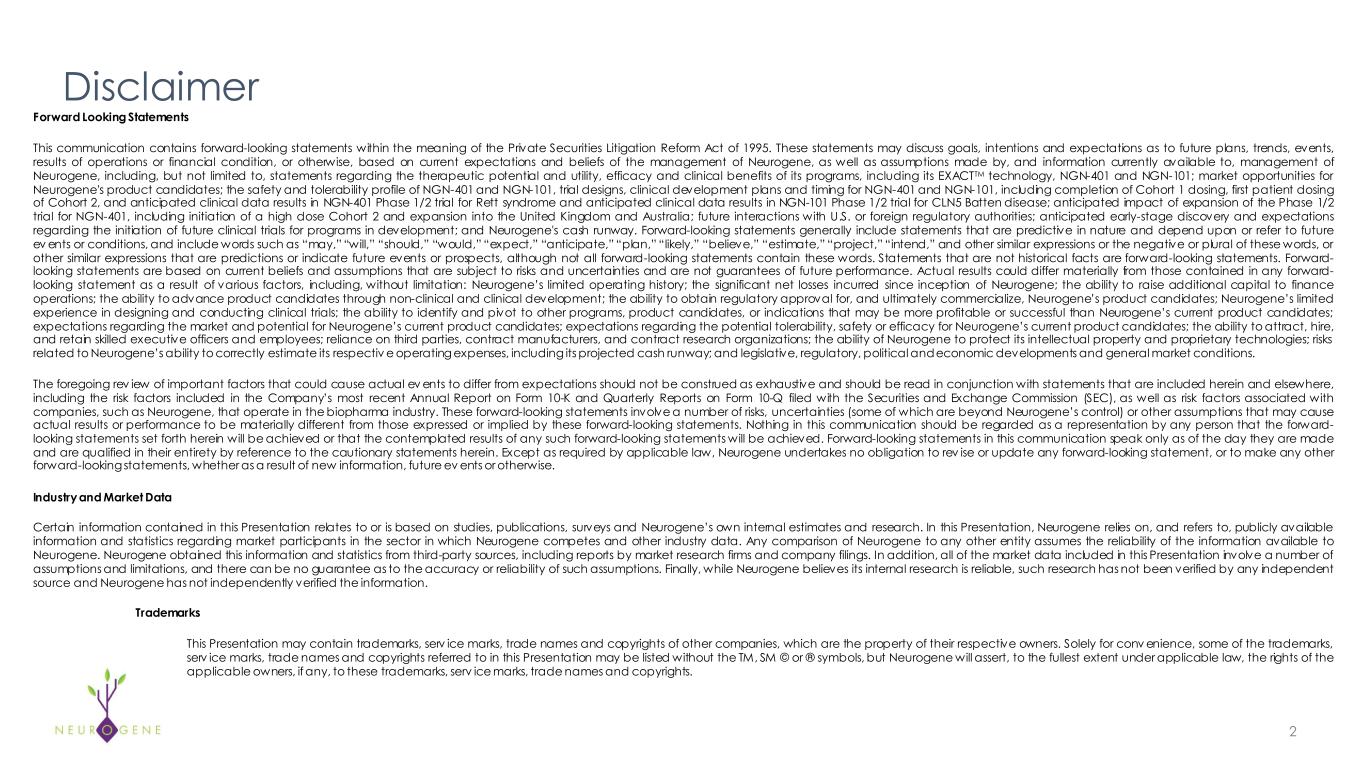
2 Disclaimer Forward Looking Statements This communication contains forward-looking statements within the meaning of the Private Securities Litigation Reform Act of 1995. These statements may discuss goals, intentions and expectations as to future plans, trends, events, results of operations or financial condition, or otherwise, based on current expectations and beliefs of the management of Neurogene, as well as assumptions made by, and information currently available to, management of Neurogene, including, but not limited to, statements regarding the therapeutic potential and utility, efficacy and clinical benefits of its programs, including its EXACTTM technology, NGN-401 and NGN-101; market opportunities for Neurogene's product candidates; the safety and tolerability profile of NGN-401 and NGN-101, trial designs, clinical development plans and timing for NGN-401 and NGN-101, including completion of Cohort 1 dosing, first patient dosing of Cohort 2, and anticipated clinical data results in NGN-401 Phase 1/2 trial for Rett syndrome and anticipated clinical data results in NGN-101 Phase 1/2 trial for CLN5 Batten disease; anticipated impact of expansion of the Phase 1/2 trial for NGN-401, including initiation of a high dose Cohort 2 and expansion into the United Kingdom and Australia; future interactions with U.S. or foreign regulatory authorities; anticipated early-stage discovery and expectations regarding the initiation of future clinical trials for programs in development; and Neurogene's cash runway. Forward-looking statements generally include statements that are predictive in nature and depend upon or refer to future ev ents or conditions, and include words such as “may,” “will,” “should,” “would,” “expect,” “anticipate,” “plan,” “likely,” “believe,” “estimate,” “project,” “intend,” and other similar expressions or the negative or plural of these words, or other similar expressions that are predictions or indicate future events or prospects, although not all forward-looking statements contain these words. Statements that are not historical facts are forward-looking statements. Forward- looking statements are based on current beliefs and assumptions that are subject to risks and uncertainties and are not guarantees of future performance. Actual results could differ materially from those contained in any forward- looking statement as a result of various factors, including, without limitation: Neurogene’s limited operating history; the significant net losses incurred since inception of Neurogene; the ability to raise additional capital to finance operations; the ability to advance product candidates through non-clinical and clinical development; the ability to obtain regulatory approval for, and ultimately commercialize, Neurogene’s product candidates; Neurogene’s limited experience in designing and conducting clinical trials; the ability to identify and pivot to other programs, product candidates, or indications that may be more profitable or successful than Neurogene’s current product candidates; expectations regarding the market and potential for Neurogene’s current product candidates; expectations regarding the potential tolerability, safety or efficacy for Neurogene’s current product candidates; the ability to attract, hire, and retain skilled executive officers and employees; reliance on third parties, contract manufacturers, and contract research organizations; the ability of Neurogene to protect its intellectual property and proprietary technologies; risks related to Neurogene’s ability to correctly estimate its respectiv e operating expenses, including its projected cash runway; and legislative, regulatory, political and economic developments and general market conditions. The foregoing rev iew of important factors that could cause actual ev ents to differ from expectations should not be construed as exhaustive and should be read in conjunction with statements that are included herein and elsewhere, including the risk factors included in the Company’s most recent Annual Report on Form 10-K and Quarterly Reports on Form 10-Q filed with the Securities and Exchange Commission (SEC), as well as risk factors associated with companies, such as Neurogene, that operate in the biopharma industry. These forward-looking statements involve a number of risks, uncertainties (some of which are beyond Neurogene’s control) or other assumptions that may cause actual results or performance to be materially different from those expressed or implied by these forward-looking statements. Nothing in this communication should be regarded as a representation by any person that the forward- looking statements set forth herein will be achieved or that the contemplated results of any such forward-looking statements will be achieved. Forward-looking statements in this communication speak only as of the day they are made and are qualified in their entirety by reference to the cautionary statements herein. Except as required by applicable law, Neurogene undertakes no obligation to rev ise or update any forward-looking statement, or to make any other forward-looking statements, whether as a result of new information, future ev ents or otherwise. Industry and Market Data Certain information contained in this Presentation relates to or is based on studies, publications, surveys and Neurogene’s own internal estimates and research. In this Presentation, Neurogene relies on, and refers to, publicly available information and statistics regarding market participants in the sector in which Neurogene competes and other industry data. Any comparison of Neurogene to any other entity assumes the reliability of the information available to Neurogene. Neurogene obtained this information and statistics from third-party sources, including reports by market research firms and company filings. In addition, all of the market data included in this Presentation involve a number of assumptions and limitations, and there can be no guarantee as to the accuracy or reliability of such assumptions. Finally, while Neurogene believes its internal research is reliable, such research has not been verified by any independent source and Neurogene has not independently verified the information. Trademarks This Presentation may contain trademarks, serv ice marks, trade names and copyrights of other companies, which are the property of their respective owners. Solely for conv enience, some of the trademarks, serv ice marks, trade names and copyrights referred to in this Presentation may be listed without the TM, SM © or ® symbols, but Neurogene will assert, to the fullest extent under applicable law, the rights of the applicable owners, if any, to these trademarks, serv ice marks, trade names and copyrights.
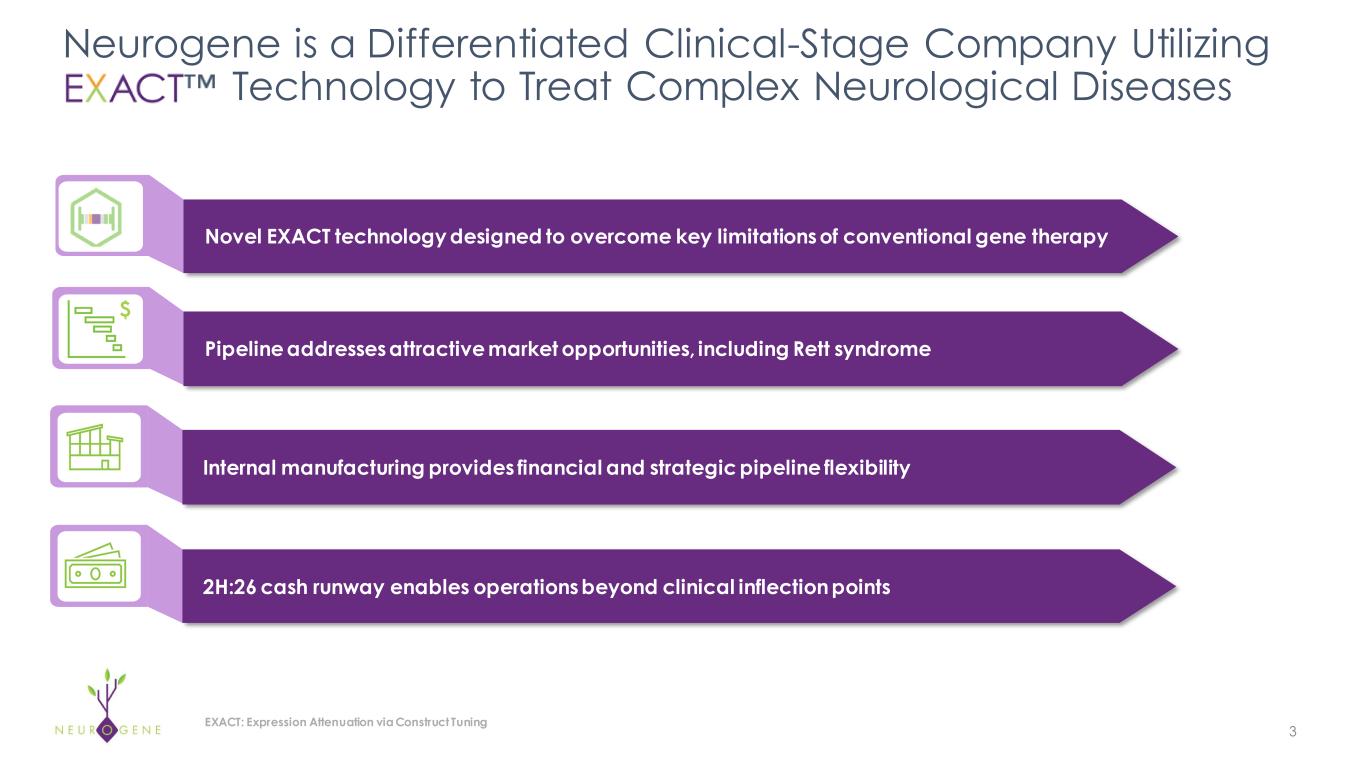
Neurogene is a Differentiated Clinical-Stage Company Utilizing EXACT Technology to Treat Complex Neurological Diseases 3 Novel EXACT technology designed to overcome key limitations of conventional gene therapy Internal manufacturing provides financial and strategic pipeline flexibility Pipeline addresses attractive market opportunities, including Rett syndrome Internal manufacturing provides financial and strategic pipeline flexibility 2H:26 cash runway enables operations beyond clinical inflection points $ EXACT: Expression Attenuation via Construct Tuning
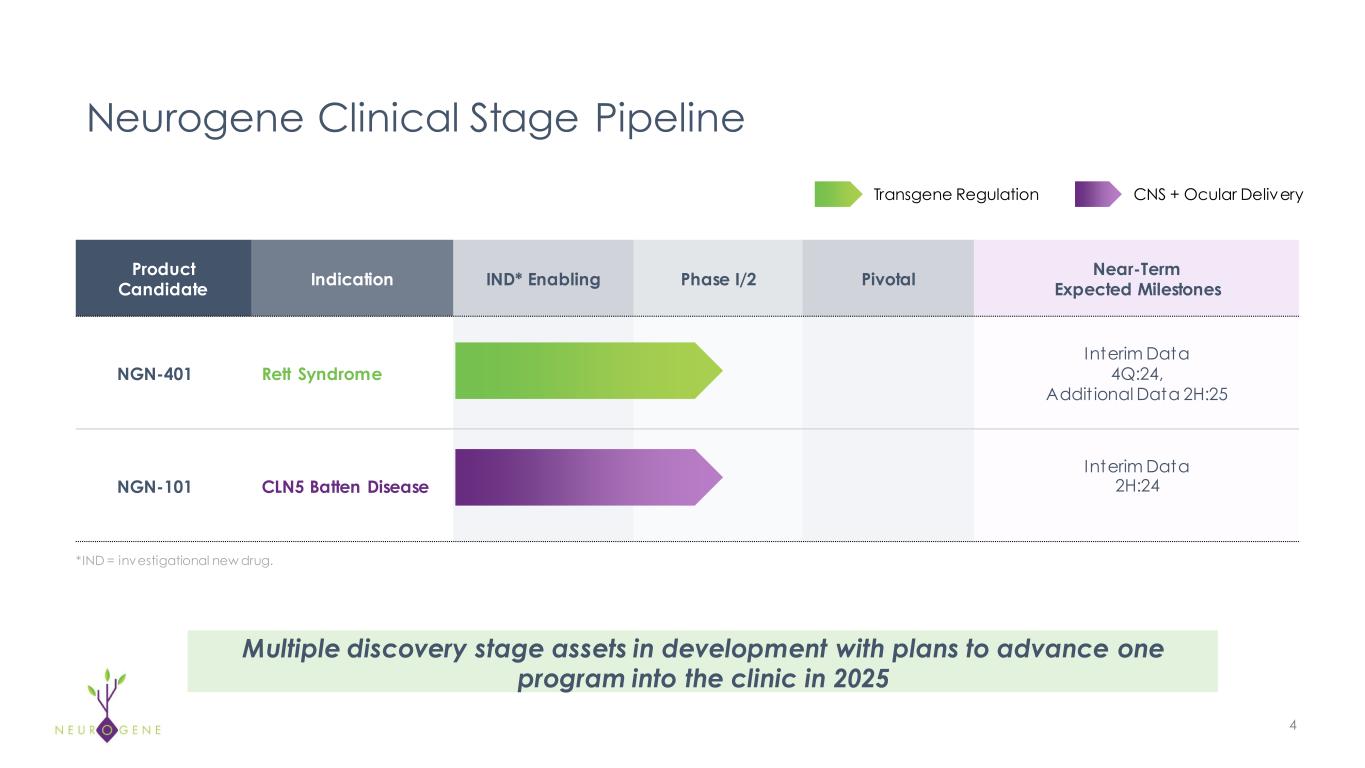
Product Candidate Indication IND* Enabling Phase I/2 Pivotal Near-Term Expected Milestones NGN-401 Rett Syndrome Interim Data 4Q:24, Addit ional Data 2H:25 NGN-101 CLN5 Batten Disease Interim Data 2H:24 Neurogene Clinical Stage Pipeline 4 *IND = investigational new drug. Transgene Regulation CNS + Ocular Delivery Multiple discovery stage assets in development with plans to advance one program into the clinic in 2025
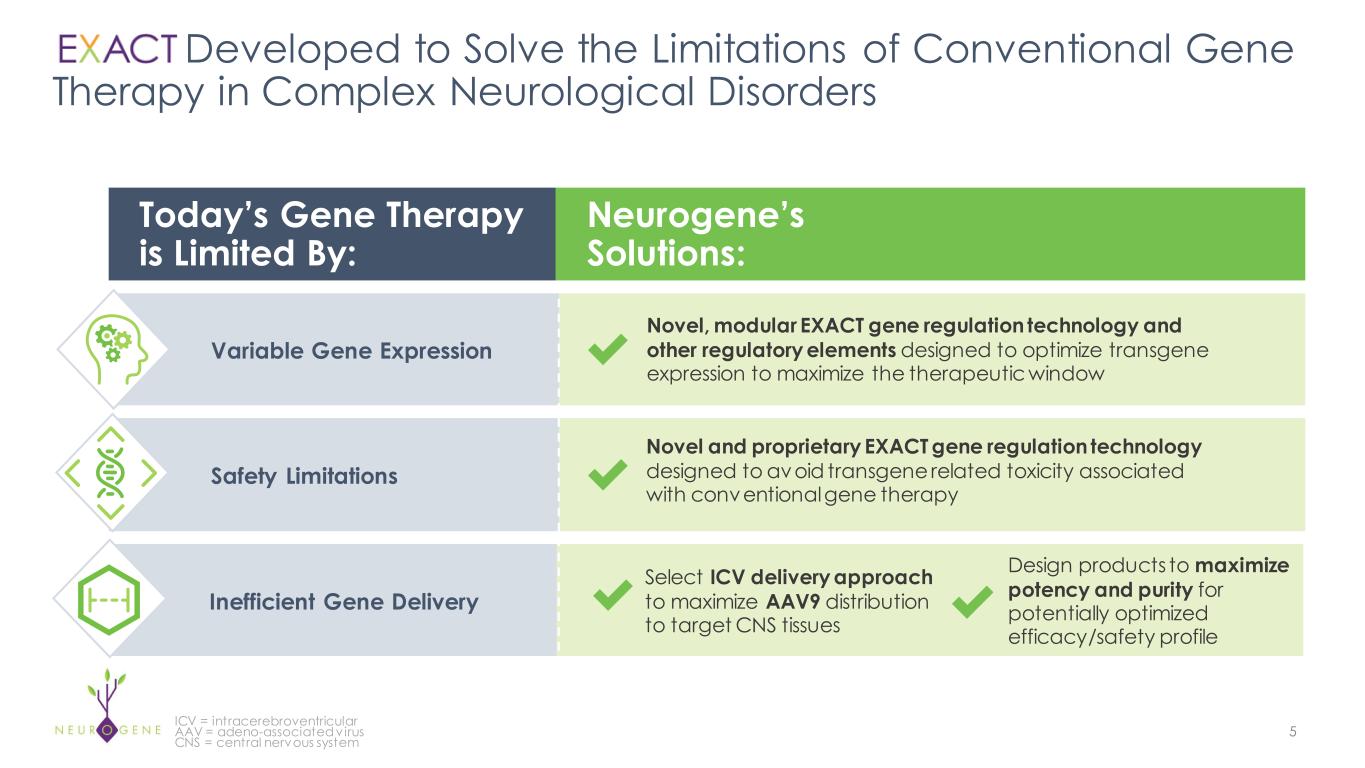
Variable Gene Expression Inefficient Gene Delivery Developed to Solve the Limitations of Conventional Gene Therapy in Complex Neurological Disorders Select ICV delivery approach to maximize AAV9 distribution to target CNS tissues Novel, modular EXACT gene regulation technology and other regulatory elements designed to optimize transgene expression to maximize the therapeutic window Safety Limitations Novel and proprietary EXACT gene regulation technology designed to avoid transgene related toxicity associated with conventional gene therapy Design products to maximize potency and purity for potentially optimized efficacy/safety profile 5 Today’s Gene Therapy is Limited By: Neurogene’s Solutions: ICV = intracerebroventricular AAV = adeno-associated v irus CNS = central nervous system
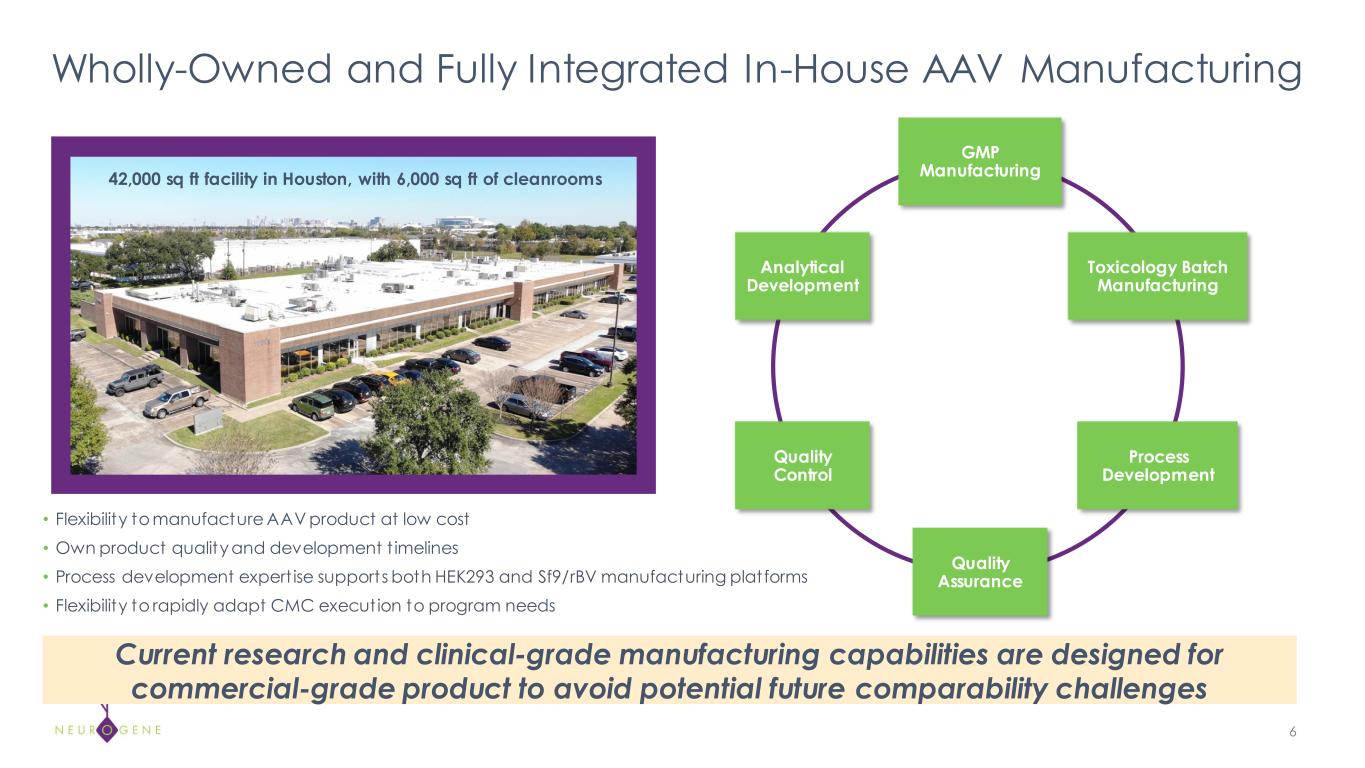
Wholly-Owned and Fully Integrated In-House AAV Manufacturing 6 GMP Manufacturing Toxicology Batch Manufacturing Process Development Quality Assurance Quality Control Analytical Development • Flexibility to manufacture AAV product at low cost • Own product quality and development t imelines • Process development expert ise supports both HEK293 and Sf9/rBV manufacturing platforms • Flexibility to rapidly adapt CMC execution to program needs 42,000 sq ft facility in Houston, with 6,000 sq ft of cleanrooms Current research and clinical-grade manufacturing capabilities are designed for commercial-grade product to avoid potential future comparability challenges
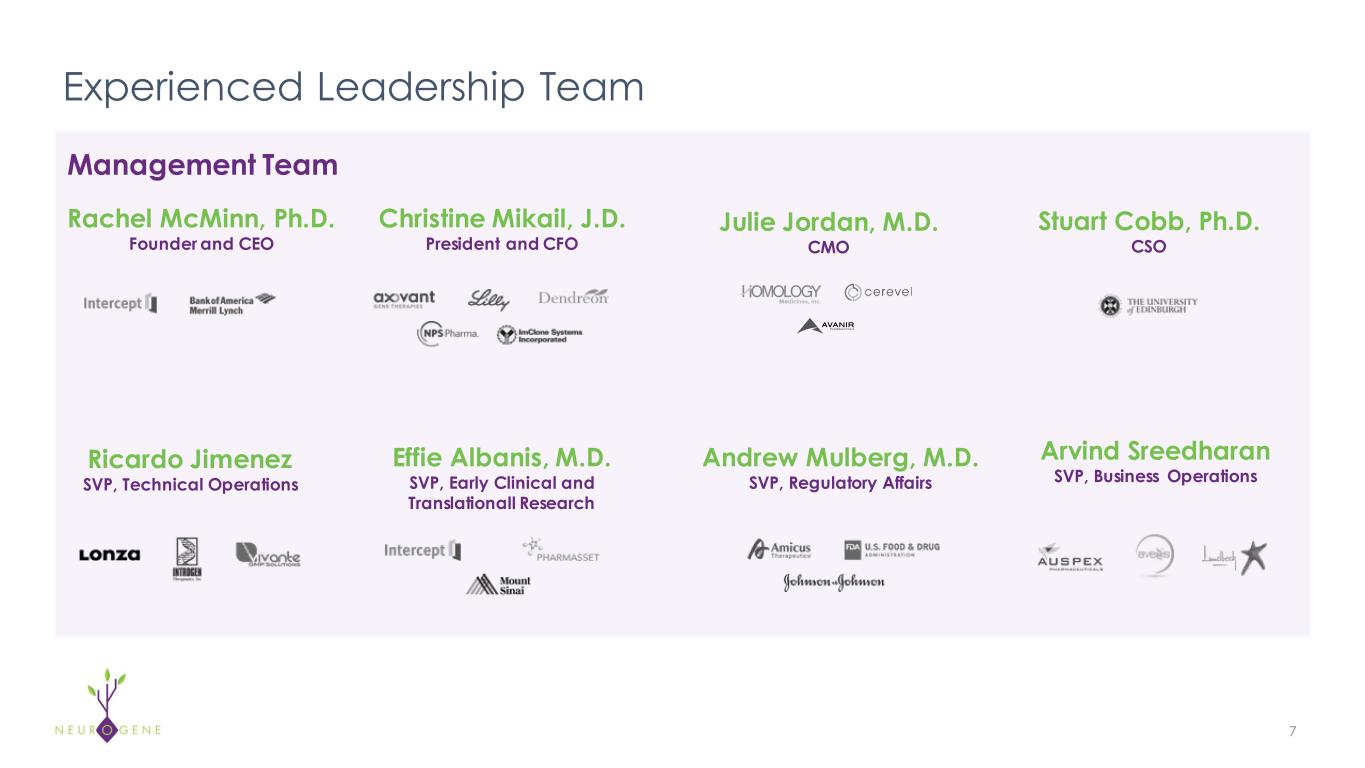
Experienced Leadership Team 7 Rachel McMinn, Ph.D. Founder and CEO Christine Mikail, J.D. President and CFO Effie Albanis, M.D. SVP, Early Clinical and Translationall Research Andrew Mulberg, M.D. SVP, Regulatory Affairs Arvind Sreedharan SVP, Business Operations Stuart Cobb, Ph.D. CSO Management Team Ricardo Jimenez SVP, Technical Operations Julie Jordan, M.D. CMO
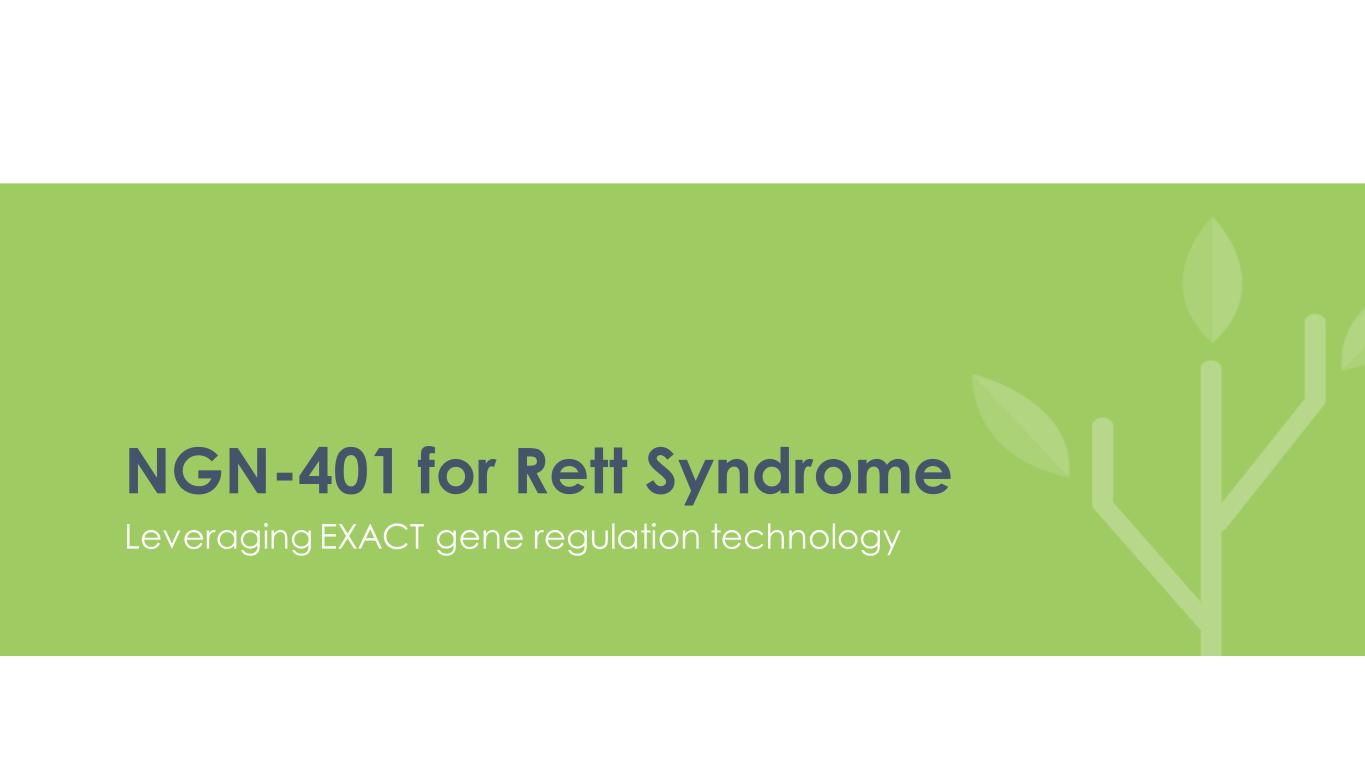
NGN-401 for Rett Syndrome Leveraging EXACT gene regulation technology
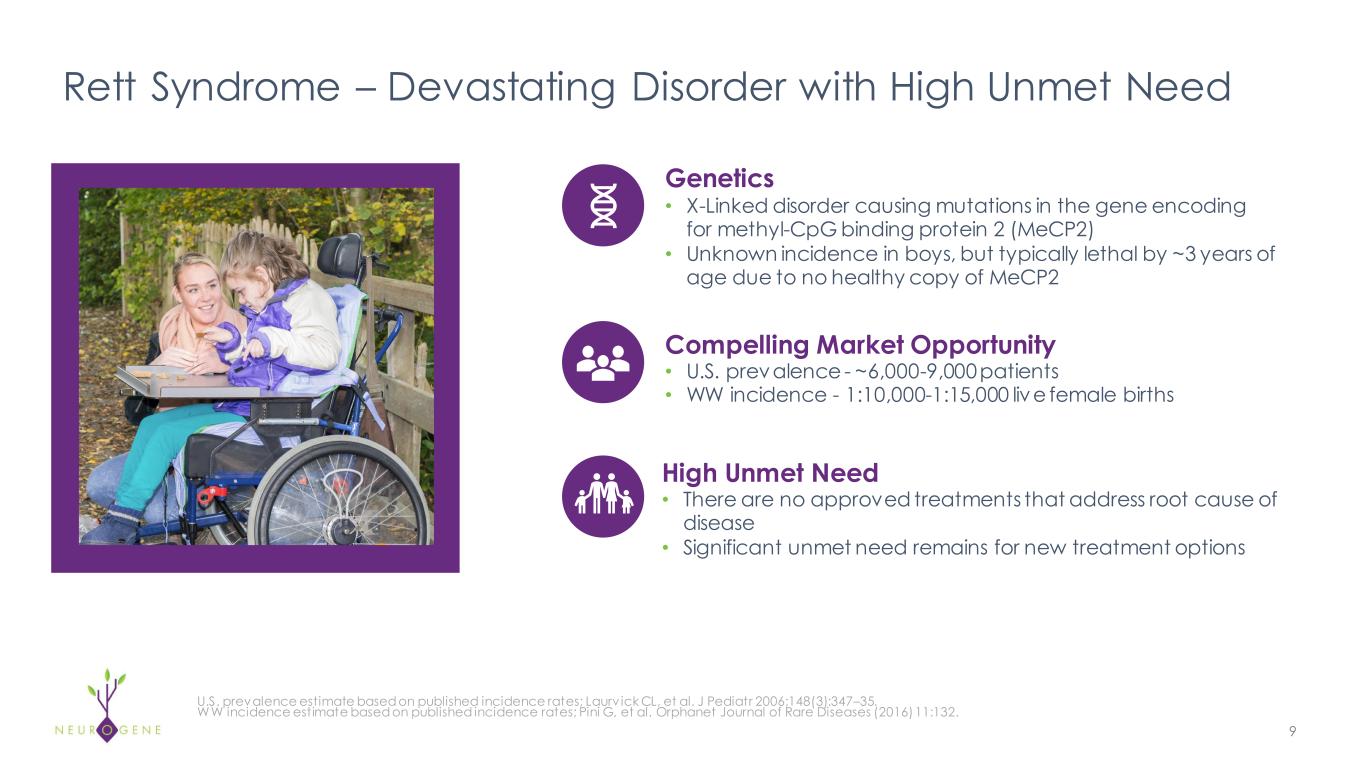
Rett Syndrome – Devastating Disorder with High Unmet Need 9 Genetics • X-Linked disorder causing mutations in the gene encoding for methyl-CpG binding protein 2 (MeCP2) • Unknown incidence in boys, but typically lethal by ~3 years of age due to no healthy copy of MeCP2 U.S. prevalence estimate based on published incidence rates; Laurv ick CL, et al. J Pediatr 2006;148(3):347–35. WW incidence estimate based on published incidence rates; Pini G, et al. Orphanet Journal of Rare Diseases (2016) 11:132. High Unmet Need • There are no approved treatments that address root cause of disease • Significant unmet need remains for new treatment options Compelling Market Opportunity • U.S. prevalence - ~6,000-9,000 patients • WW incidence - 1:10,000-1:15,000 live female births
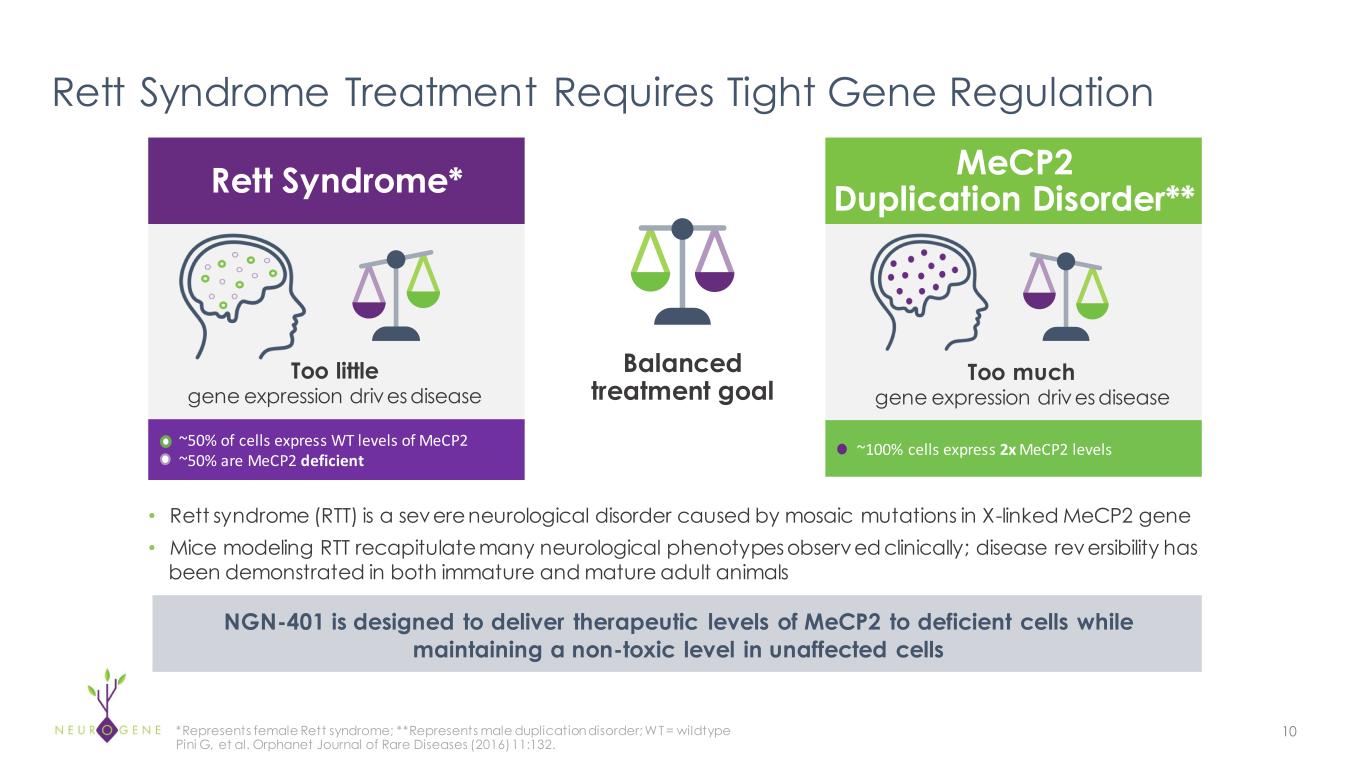
• Rett syndrome (RTT) is a severe neurological disorder caused by mosaic mutations in X-linked MeCP2 gene • Mice modeling RTT recapitulate many neurological phenotypes observed clinically; disease reversibility has been demonstrated in both immature and mature adult animals 10 ~100% cells express 2x MeCP2 levels ~50% of cells express WT levels of MeCP2 ~50% are MeCP2 deficient Too little gene expression drives disease Too much gene expression drives disease Balanced treatment goal Rett Syndrome Treatment Requires Tight Gene Regulation *Represents female Rett syndrome; **Represents male duplication disorder; WT = wildtype Pini G, et al. Orphanet Journal of Rare Diseases (2016) 11:132. Rett Syndrome* MeCP2 Duplication Disorder** NGN-401 is designed to deliver therapeutic levels of MeCP2 to deficient cells while maintaining a non-toxic level in unaffected cells
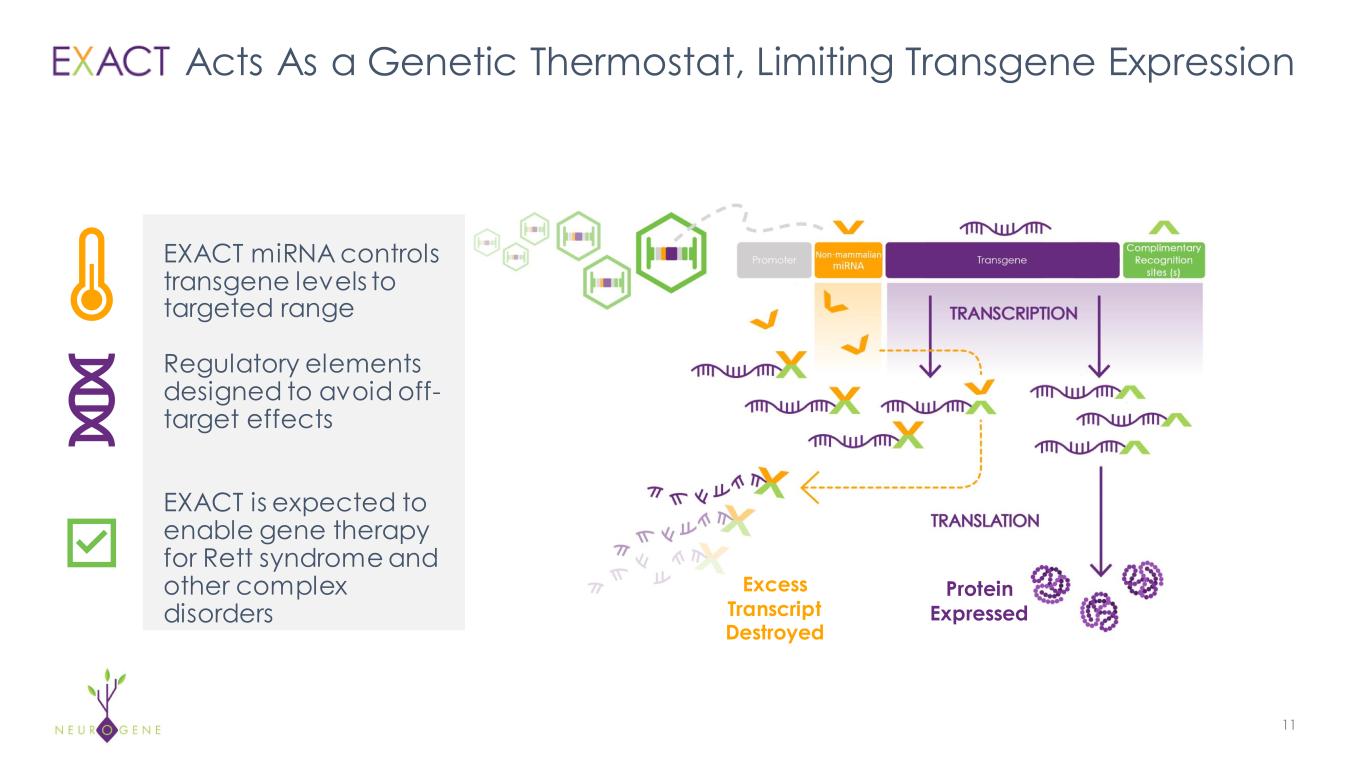
Acts As a Genetic Thermostat, Limiting Transgene Expression 11 Protein Expressed EXACT miRNA controls transgene levels to targeted range Regulatory elements designed to avoid off- target effects EXACT is expected to enable gene therapy for Rett syndrome and other complex disorders Excess Transcript Destroyed
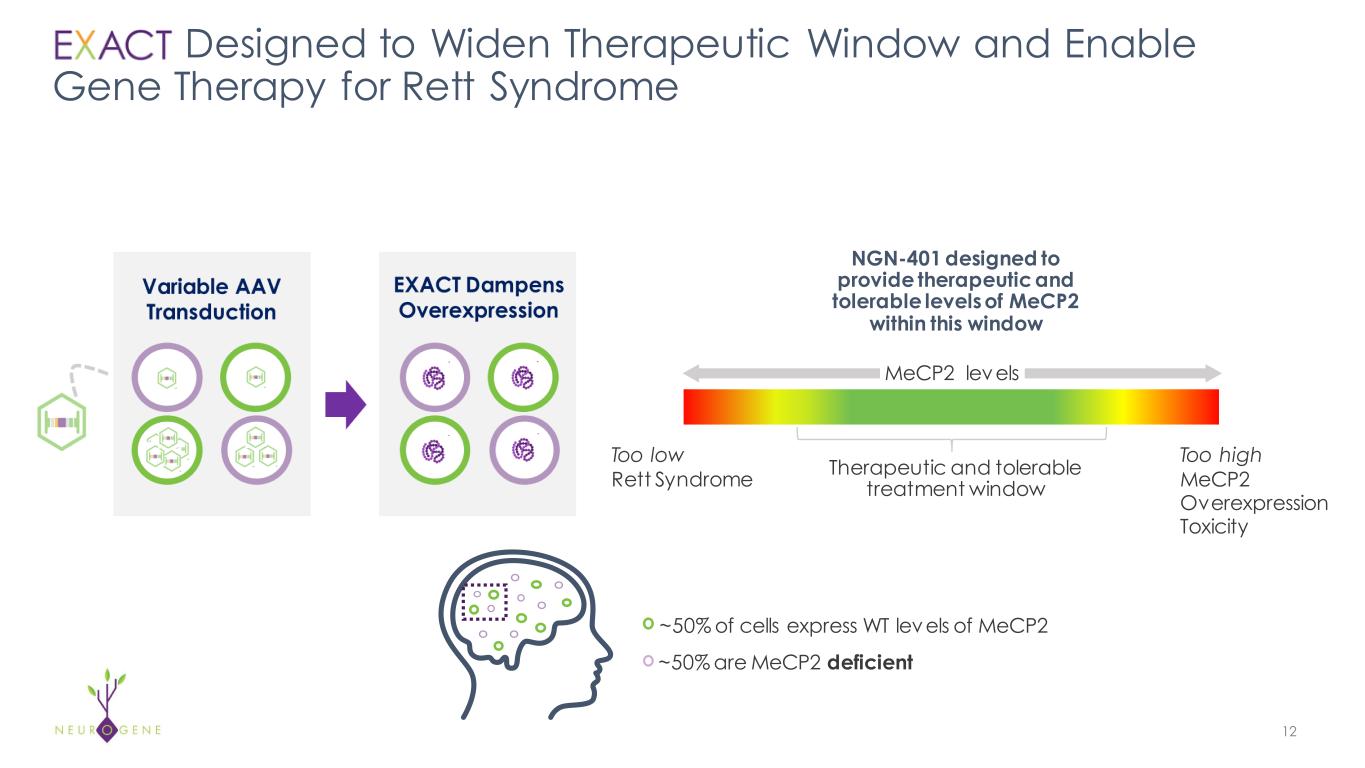
12 Designed to Widen Therapeutic Window and Enable Gene Therapy for Rett Syndrome ~50% of cells express WT levels of MeCP2 ~50% are MeCP2 deficient NGN-401 designed to provide therapeutic and tolerable levels of MeCP2 within this window Too low Rett Syndrome Too high MeCP2 Overexpression Toxicity Therapeutic and tolerable treatment window MeCP2 levels
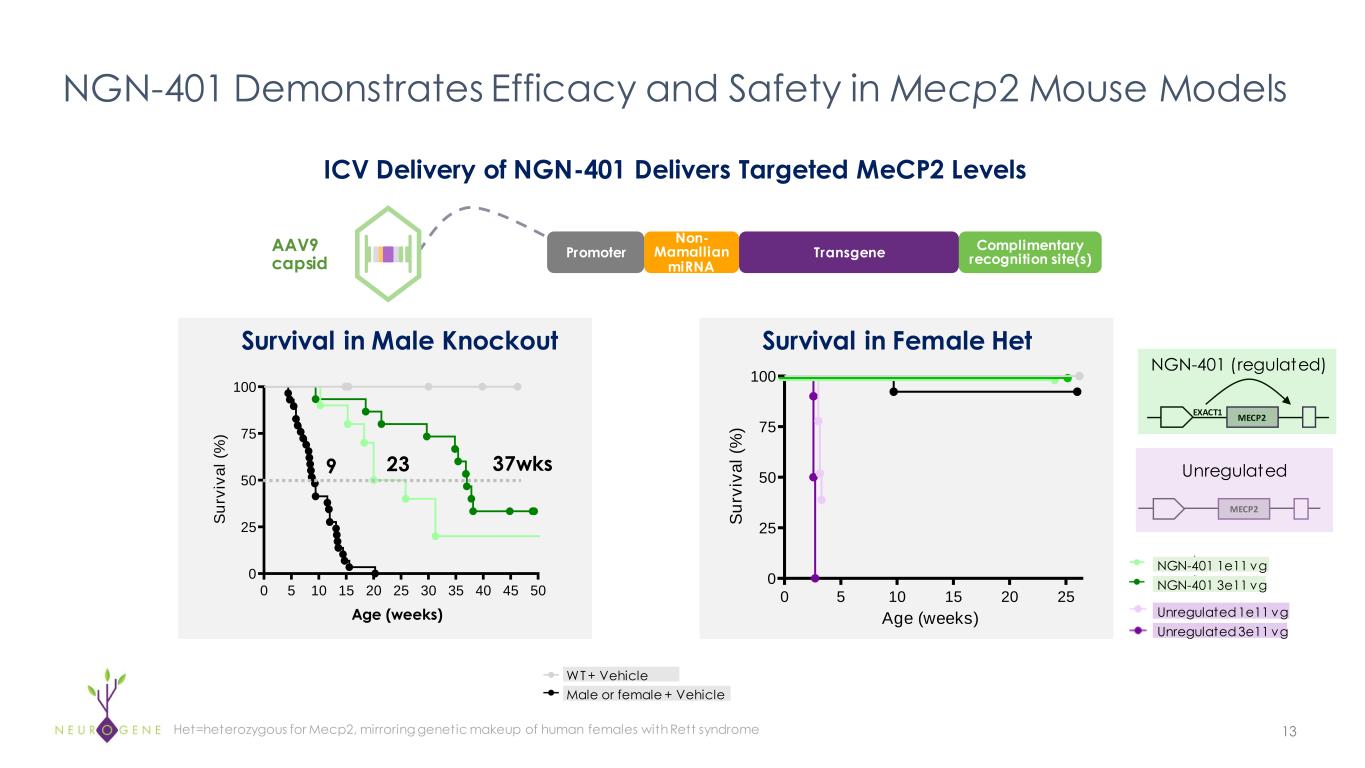
NGN-401 Demonstrates Efficacy and Safety in Mecp2 Mouse Models 13 Survival in Male Knockout 0 5 10 15 20 25 30 35 40 45 50 0 25 50 75 100 S u rv iv a l (% ) 9 23 37wks Age (weeks) 0 5 10 15 20 25 0 25 50 75 100 Age (weeks) S u rv iv a l (% ) Survival in Female Het NGN-401 1e11 vg NGN-401 3e11 vg MECP2 EXACT1 NGN-401 (regulated) MECP2 Unregulated Unregulated 1e11 vg Unregulated 3e11 vg WT + Vehicle Male or female + Vehicle Het=heterozygous for Mecp2, mirroring genetic makeup of human females with Rett syndrome ICV Delivery of NGN-401 Delivers Targeted MeCP2 Levels AAV9 capsid Non- Mamallian miRNA Transgene Complimentary recognition site(s)Promoter
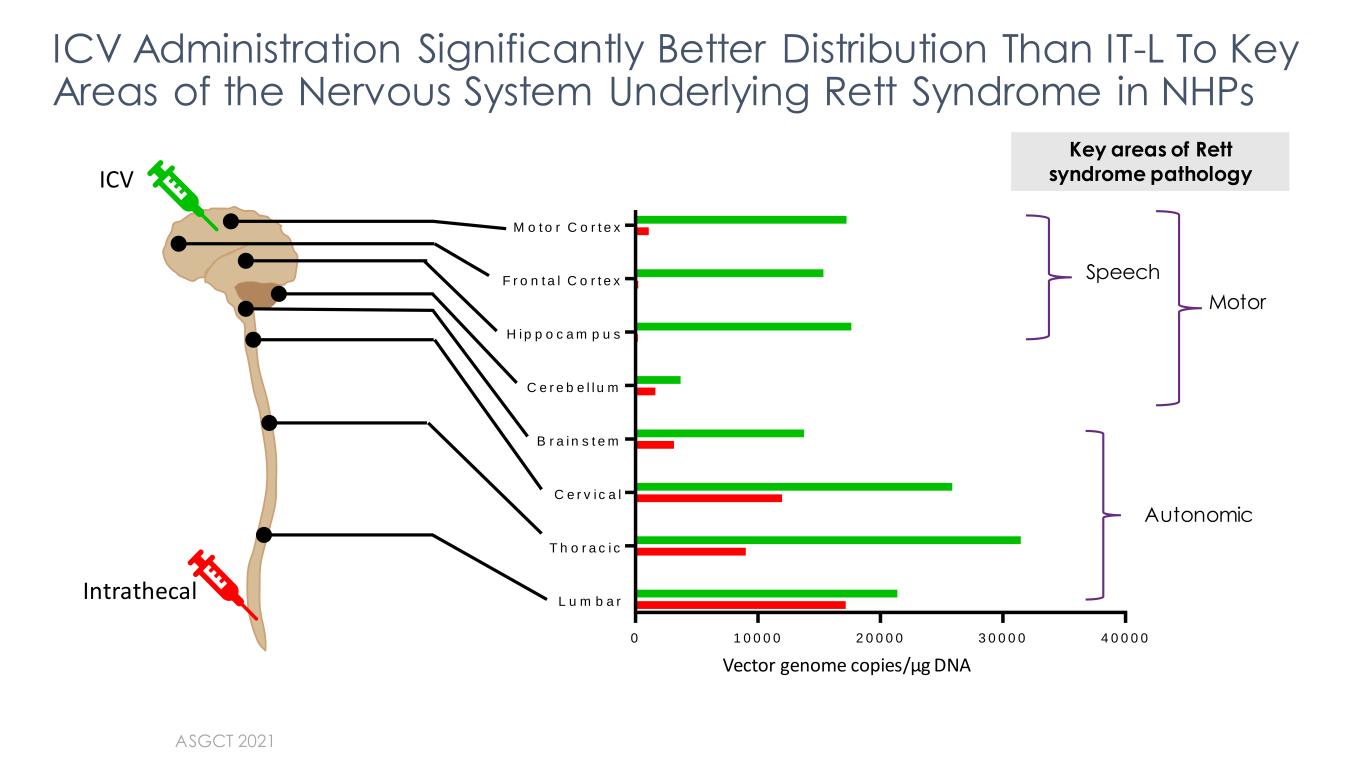
0 1 0 0 0 0 2 0 0 0 0 3 0 0 0 0 4 0 0 0 0 L u m b a r T h o ra c ic C e rv ic a l B ra in s te m C e re b e llu m H ip p o c a m p u s F ro n ta l C o r te x M o to r C o r te x ICV Administration Significantly Better Distribution Than IT-L To Key Areas of the Nervous System Underlying Rett Syndrome in NHPs ICV Intrathecal Vector genome copies/µg DNA Motor Autonomic Speech Key areas of Rett syndrome pathology ASGCT 2021

NGN-401 Preclinical Data Enabled Pediatric Clinical Approach 15 Promising efficacy, favorable safety profile DEMONSTRATED CONTROLLED MeCP2 LEVELS Robust MeCP2 levels to key brain areas PROVIDES TRANSLATIONAL FOUNDATION FOR HUMANS No evidence of off-target or MeCP2 tox GENERATED COMPREHENSIVE SAFETY PACKAGE Delivery of full-length MECP2 MAXIMIZES THERAPEUTIC POTENTIAL U.S. FDA, UK MHRA and Australian HREC cleared dosing directly into pediatric patients
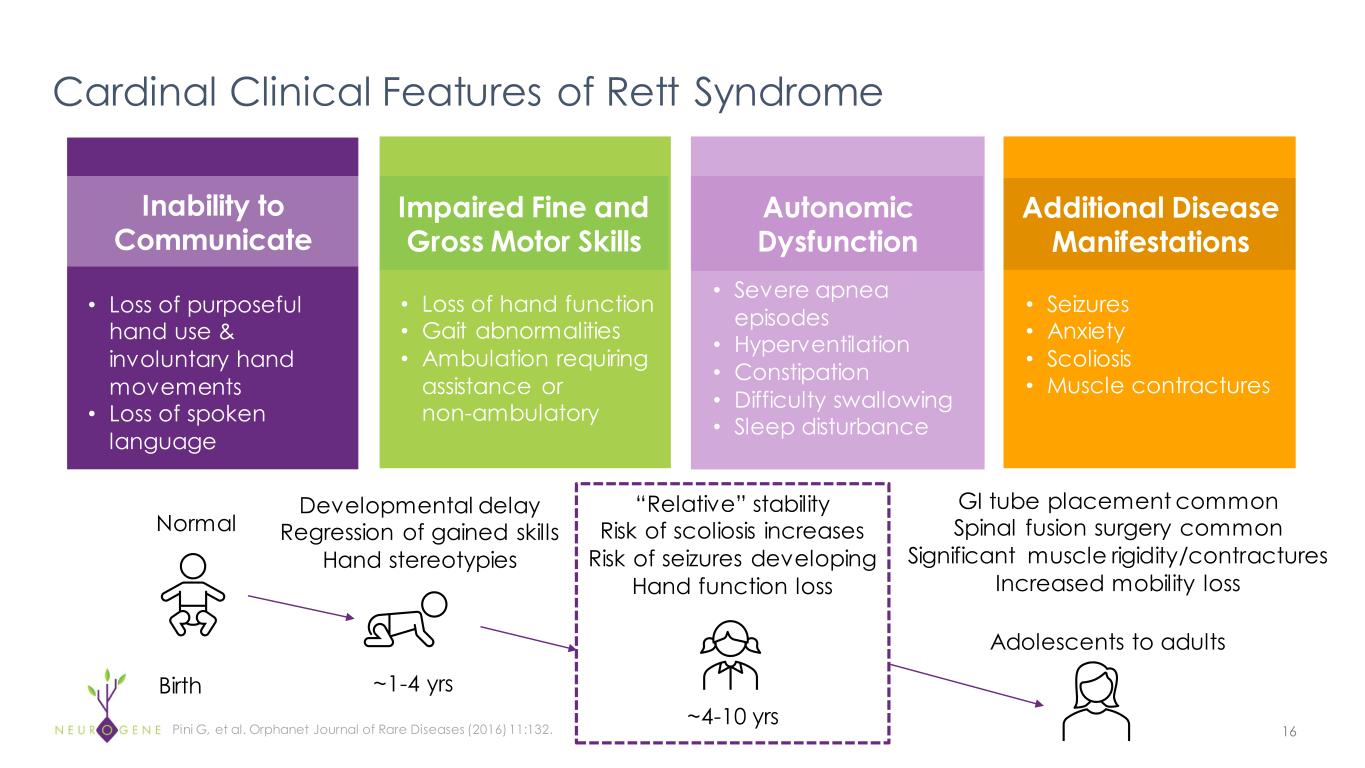
“Relative” stability Risk of scoliosis increases Risk of seizures developing Hand function loss Cardinal Clinical Features of Rett Syndrome • Loss of purposeful hand use & involuntary hand movements • Loss of spoken language • Loss of hand function • Gait abnormalities • Ambulation requiring assistance or non-ambulatory • Severe apnea episodes • Hyperventilation • Constipation • Difficulty swallowing • Sleep disturbance • Seizures • Anxiety • Scoliosis • Muscle contractures Inability to Communicate Impaired Fine and Gross Motor Skills Autonomic Dysfunction Additional Disease Manifestations 16Pini G, et al. Orphanet Journal of Rare Diseases (2016) 11:132. Normal Developmental delay Regression of gained skills Hand stereotypies GI tube placement common Spinal fusion surgery common Significant muscle rigidity/contractures Increased mobility loss Birth ~1-4 yrs ~4-10 yrs Adolescents to adults
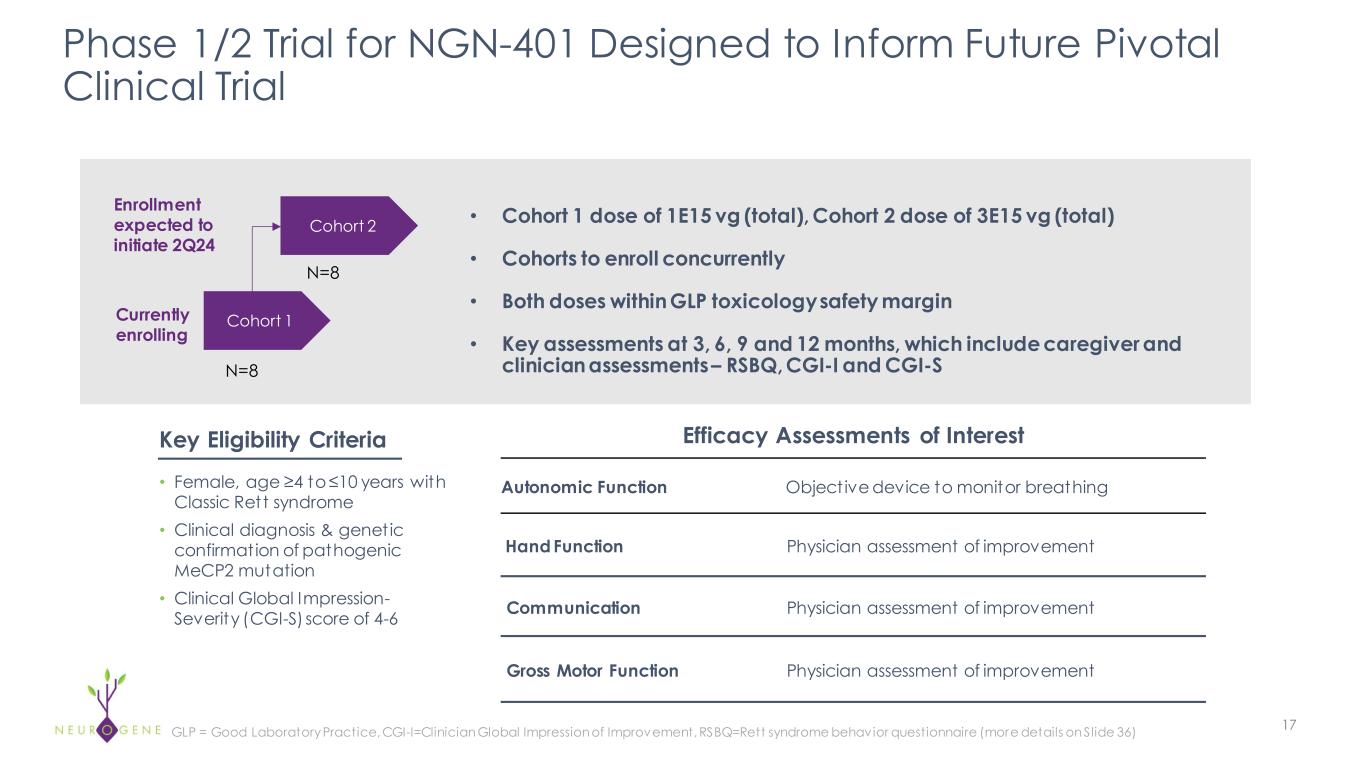
Key Eligibility Criteria • Female, age ≥4 to ≤10 years with Classic Rett syndrome • Clinical diagnosis & genetic confirmation of pathogenic MeCP2 mutation • Clinical Global Impression- Severity (CGI-S) score of 4-6 Efficacy Assessments of Interest Autonomic Function Objective device to monitor breathing Hand Function Physician assessment of improvement Communication Physician assessment of improvement Gross Motor Function Physician assessment of improvement Currently enrolling • Cohort 1 dose of 1E15 vg (total), Cohort 2 dose of 3E15 vg (total) • Cohorts to enroll concurrently • Both doses within GLP toxicology safety margin • Key assessments at 3, 6, 9 and 12 months, which include caregiver and clinician assessments – RSBQ, CGI-I and CGI-S Phase 1/2 Trial for NGN-401 Designed to Inform Future Pivotal Clinical Trial 17 GLP = Good Laboratory Practice, CGI-I=Clinician Global Impression of Improvement, RSBQ=Rett syndrome behavior questionnaire (more details on Slide 36) Enrollment expected to initiate 2Q24 Cohort 1 N=8 Cohort 2 N=8
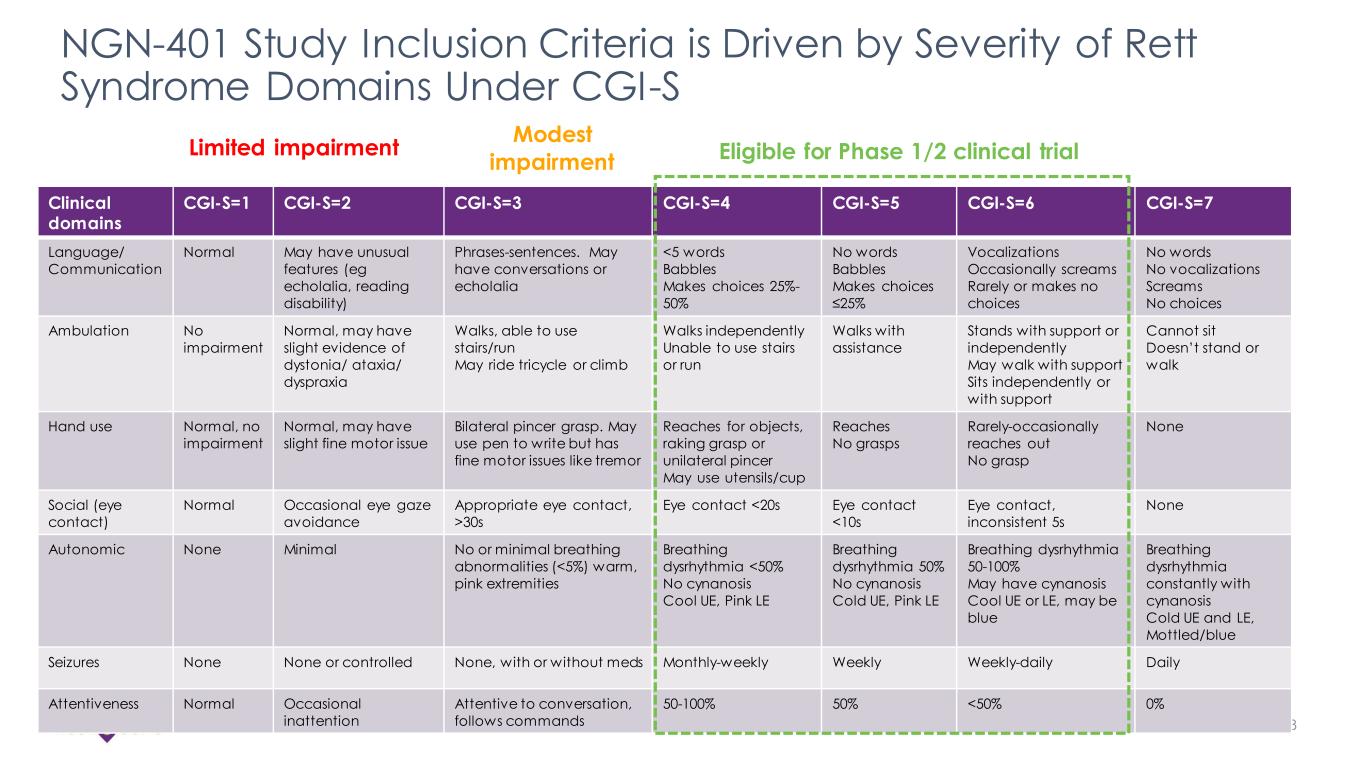
NGN-401 Study Inclusion Criteria is Driven by Severity of Rett Syndrome Domains Under CGI-S 18 Clinical domains CGI-S=1 CGI-S=2 CGI-S=3 CGI-S=4 CGI-S=5 CGI-S=6 CGI-S=7 Language/ Communication Normal May have unusual features (eg echolalia, reading disability) Phrases-sentences. May have conversations or echolalia <5 words Babbles Makes choices 25%- 50% No words Babbles Makes choices ≤25% Vocalizations Occasionally screams Rarely or makes no choices No words No vocalizations Screams No choices Ambulation No impairment Normal, may have slight evidence of dystonia/ ataxia/ dyspraxia Walks, able to use stairs/run May ride tricycle or climb Walks independently Unable to use stairs or run Walks with assistance Stands with support or independently May walk with support Sits independently or with support Cannot sit Doesn’t stand or walk Hand use Normal, no impairment Normal, may have slight fine motor issue Bilateral pincer grasp. May use pen to write but has fine motor issues like tremor Reaches for objects, raking grasp or unilateral pincer May use utensils/cup Reaches No grasps Rarely-occasionally reaches out No grasp None Social (eye contact) Normal Occasional eye gaze avoidance Appropriate eye contact, >30s Eye contact <20s Eye contact <10s Eye contact, inconsistent 5s None Autonomic None Minimal No or minimal breathing abnormalities (<5%) warm, pink extremities Breathing dysrhythmia <50% No cynanosis Cool UE, Pink LE Breathing dysrhythmia 50% No cynanosis Cold UE, Pink LE Breathing dysrhythmia 50-100% May have cynanosis Cool UE or LE, may be blue Breathing dysrhythmia constantly with cynanosis Cold UE and LE, Mottled/blue Seizures None None or controlled None, with or without meds Monthly-weekly Weekly Weekly-daily Daily Attentiveness Normal Occasional inattention Attentive to conversation, follows commands 50-100% 50% <50% 0% Eligible for Phase 1/2 clinical trial Modest impairment Limited impairment
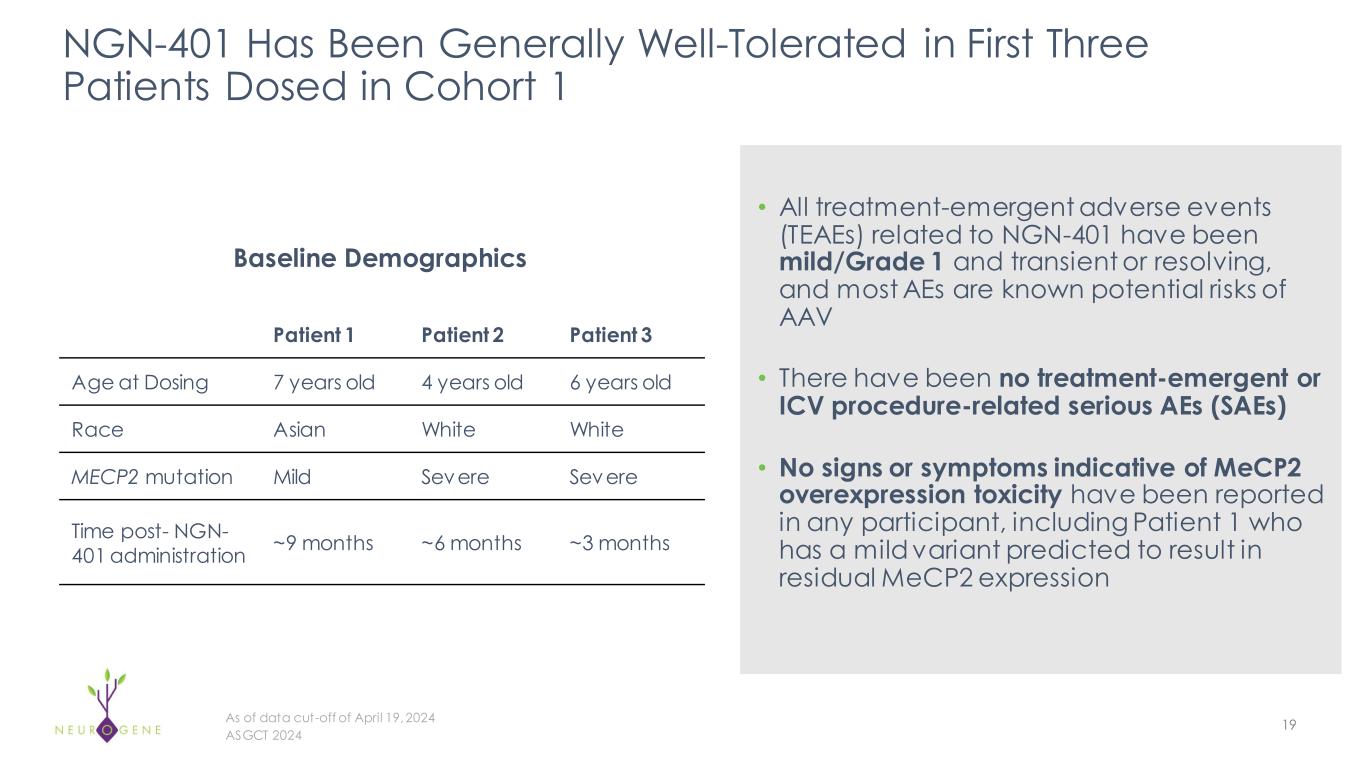
NGN-401 Has Been Generally Well-Tolerated in First Three Patients Dosed in Cohort 1 19 As of data cut-off of April 19, 2024 Patient 1 Patient 2 Patient 3 Age at Dosing 7 years old 4 years old 6 years old Race Asian White White MECP2 mutation Mild Severe Severe Time post- NGN- 401 administration ~9 months ~6 months ~3 months • All treatment-emergent adverse events (TEAEs) related to NGN-401 have been mild/Grade 1 and transient or resolving, and most AEs are known potential risks of AAV • There have been no treatment-emergent or ICV procedure-related serious AEs (SAEs) • No signs or symptoms indicative of MeCP2 overexpression toxicity have been reported in any participant, including Patient 1 who has a mild variant predicted to result in residual MeCP2 expression Baseline Demographics ASGCT 2024
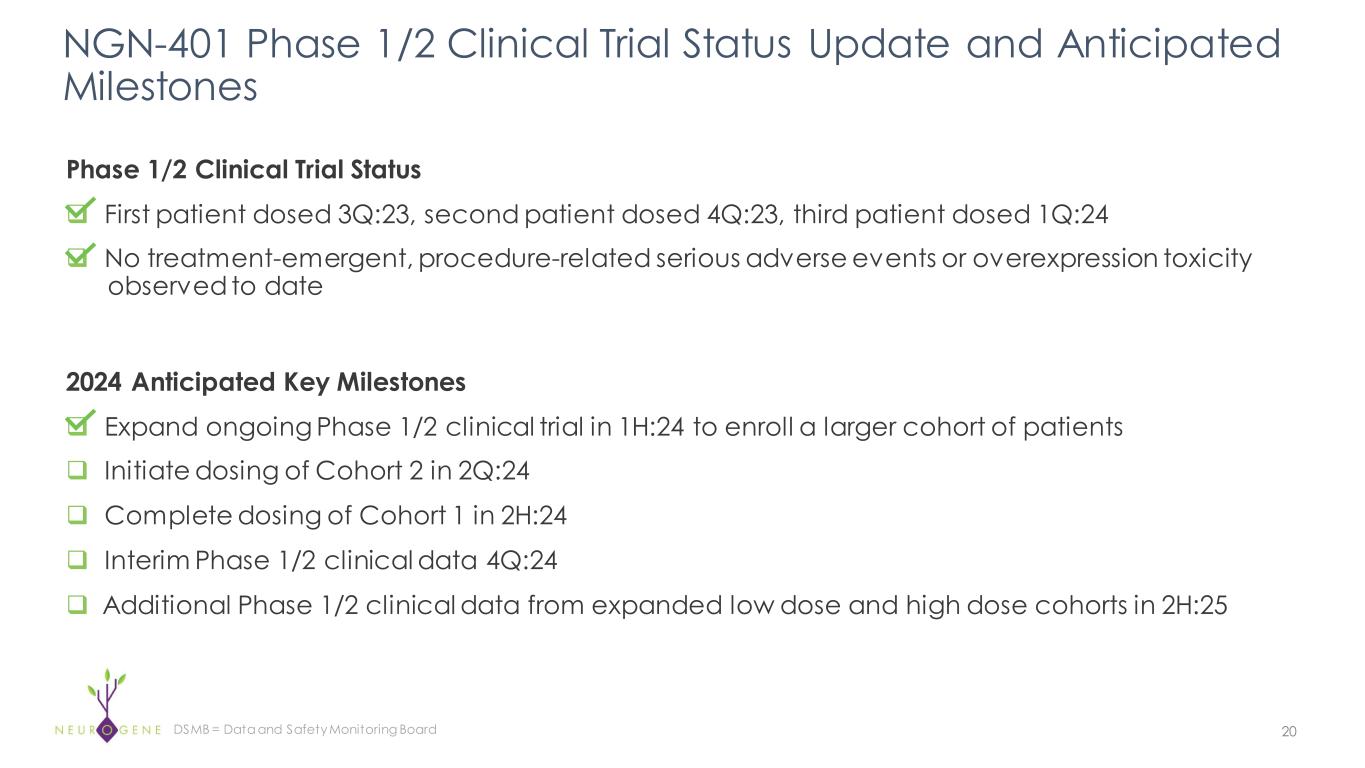
Phase 1/2 Clinical Trial Status ❑ First patient dosed 3Q:23, second patient dosed 4Q:23, third patient dosed 1Q:24 ❑ No treatment-emergent, procedure-related serious adverse events or overexpression toxicity observed to date NGN-401 Phase 1/2 Clinical Trial Status Update and Anticipated Milestones 20 2024 Anticipated Key Milestones ❑ Expand ongoing Phase 1/2 clinical trial in 1H:24 to enroll a larger cohort of patients ❑ Initiate dosing of Cohort 2 in 2Q:24 ❑ Complete dosing of Cohort 1 in 2H:24 ❑ Interim Phase 1/2 clinical data 4Q:24 ❑ Additional Phase 1/2 clinical data from expanded low dose and high dose cohorts in 2H:25 DSMB = Data and Safety Monitoring Board
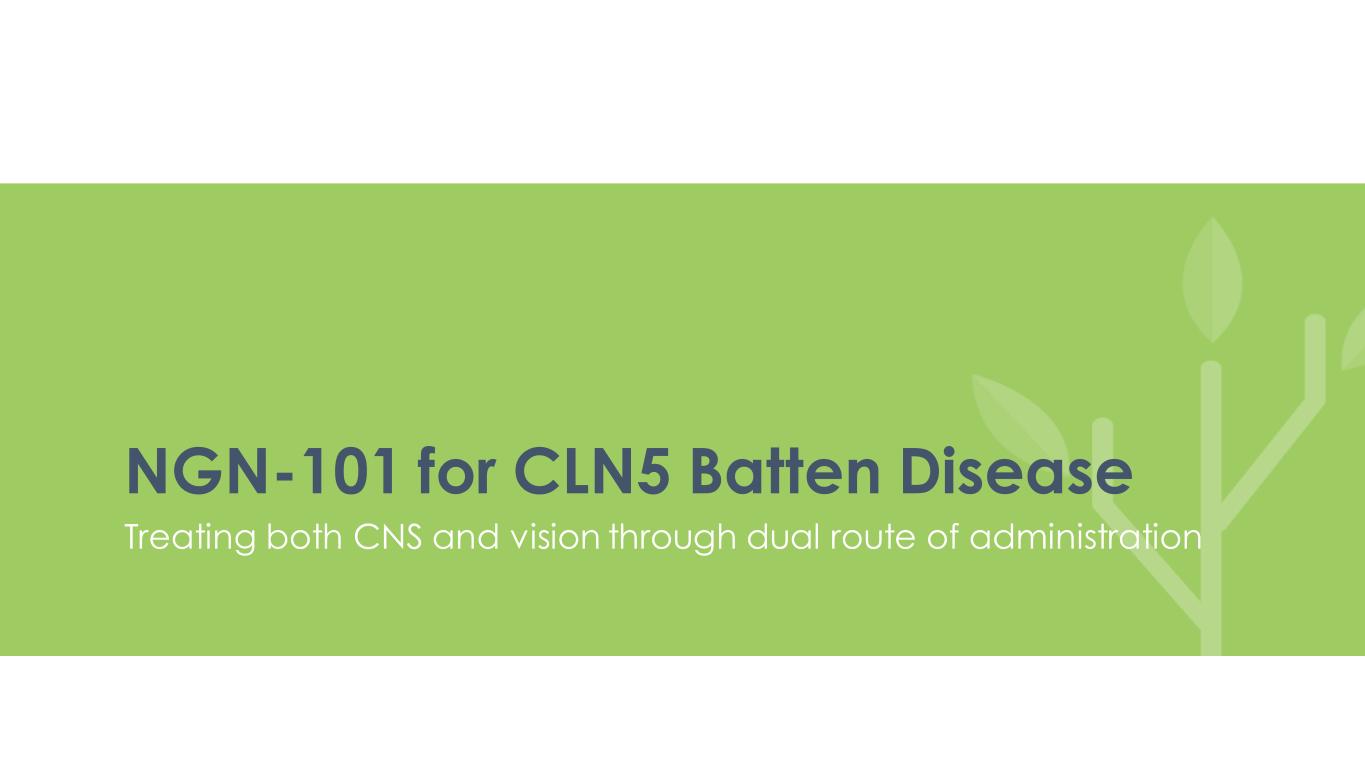
NGN-101 for CLN5 Batten Disease Treating both CNS and vision through dual route of administration
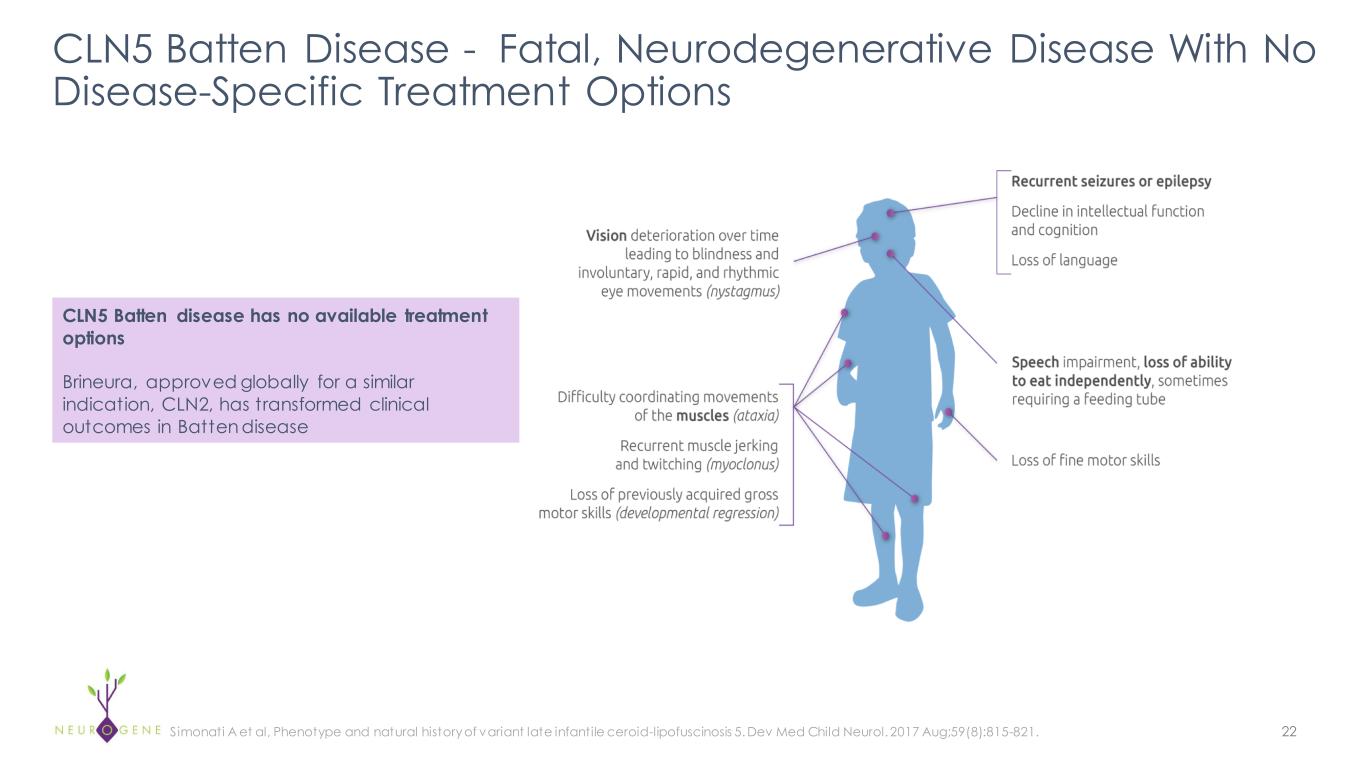
CLN5 Batten Disease - Fatal, Neurodegenerative Disease With No Disease-Specific Treatment Options 22 CLN5 Batten disease has no available treatment options Brineura, approved globally for a similar indication, CLN2, has transformed clinical outcomes in Batten disease Simonati A et al, Phenotype and natural history of variant late infantile ceroid-lipofuscinosis 5. Dev Med Child Neurol. 2017 Aug;59(8):815-821.
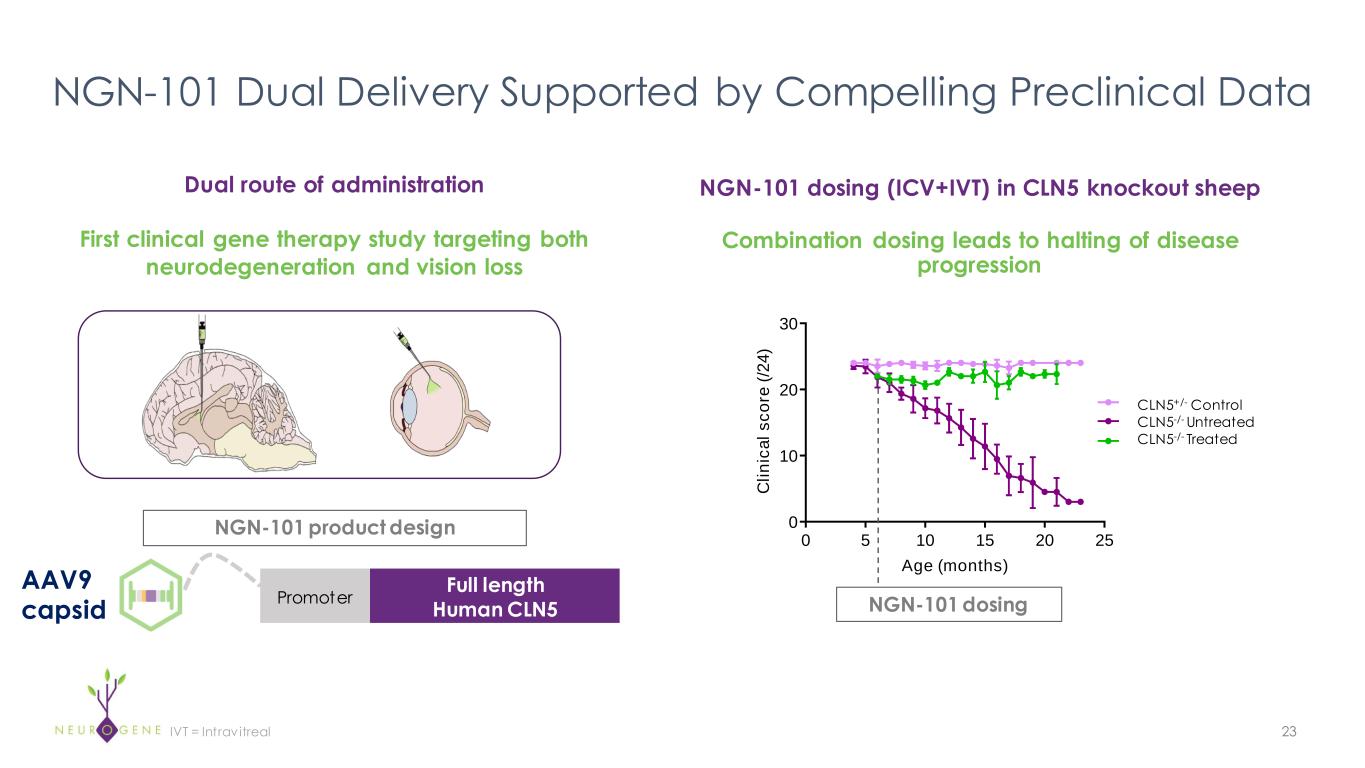
NGN-101 Dual Delivery Supported by Compelling Preclinical Data 23 Dual route of administration First clinical gene therapy study targeting both neurodegeneration and vision loss 0 5 10 15 20 25 0 10 20 30 Age (months) C li n ic a l s c o re ( /2 4 ) CLN5 +/- Control CLN5 -/- Untreated CLN5 -/- High Dose NGN-101 dosing (ICV+IVT) in CLN5 knockout sheep Combination dosing leads to halting of disease progression CLN5+/- Control CLN5-/- Untreated CLN5-/- Treated NGN-101 dosing NGN-101 product design Promoter Full length Human CLN5 AAV9 capsid IVT = Intravitreal
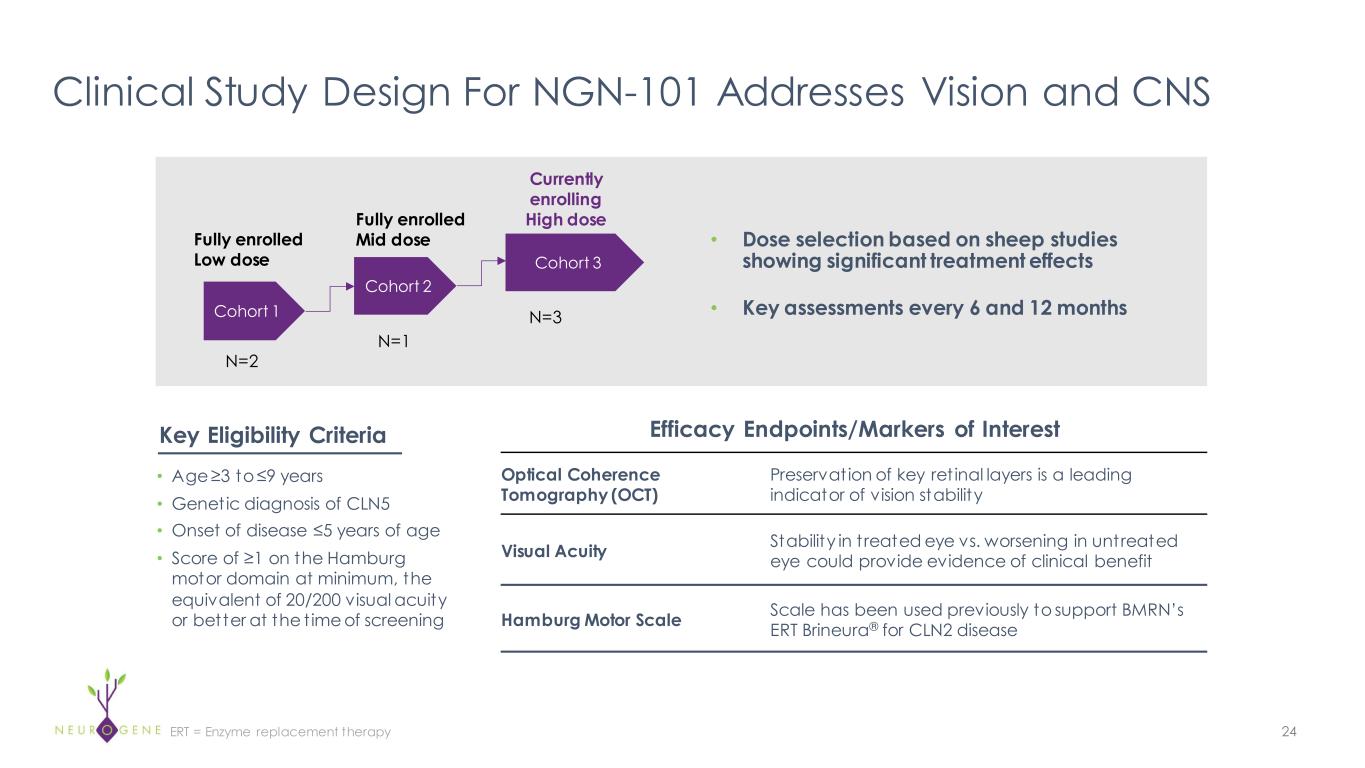
Clinical Study Design For NGN-101 Addresses Vision and CNS 24 Cohort 1 Cohort 3 N=2 N=3 Fully enrolled Low dose Currently enrolling High dose • Dose selection based on sheep studies showing significant treatment effects • Key assessments every 6 and 12 months • Age ≥3 to ≤9 years • Genetic diagnosis of CLN5 • Onset of disease ≤5 years of age • Score of ≥1 on the Hamburg motor domain at minimum, the equivalent of 20/200 visual acuity or better at the t ime of screening Efficacy Endpoints/Markers of Interest Optical Coherence Tomography (OCT) Preservation of key ret inal layers is a leading indicator of vision stability Visual Acuity Stability in t reated eye vs. worsening in untreated eye could provide evidence of clinical benefit Hamburg Motor Scale Scale has been used previously to support BMRN’s ERT Brineura® for CLN2 disease Key Eligibility Criteria ERT = Enzyme replacement therapy Cohort 2 N=1 Fully enrolled Mid dose
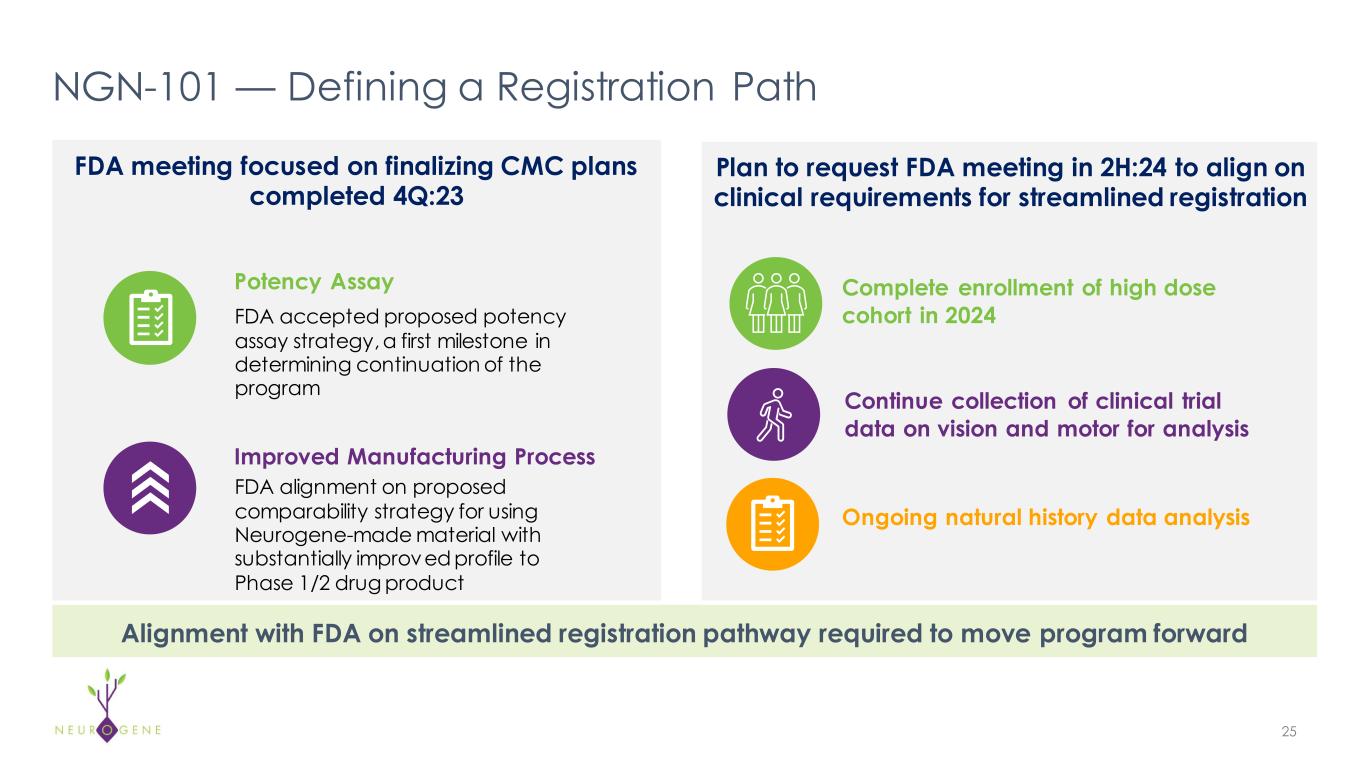
NGN-101 — Defining a Registration Path 25 Plan to request FDA meeting in 2H:24 to align on clinical requirements for streamlined registration FDA meeting focused on finalizing CMC plans completed 4Q:23 FDA alignment on proposed comparability strategy for using Neurogene-made material with substantially improved profile to Phase 1/2 drug product Improved Manufacturing Process FDA accepted proposed potency assay strategy, a first milestone in determining continuation of the program Potency Assay Complete enrollment of high dose cohort in 2024 Continue collection of clinical trial data on vision and motor for analysis Ongoing natural history data analysis Alignment with FDA on streamlined registration pathway required to move program forward
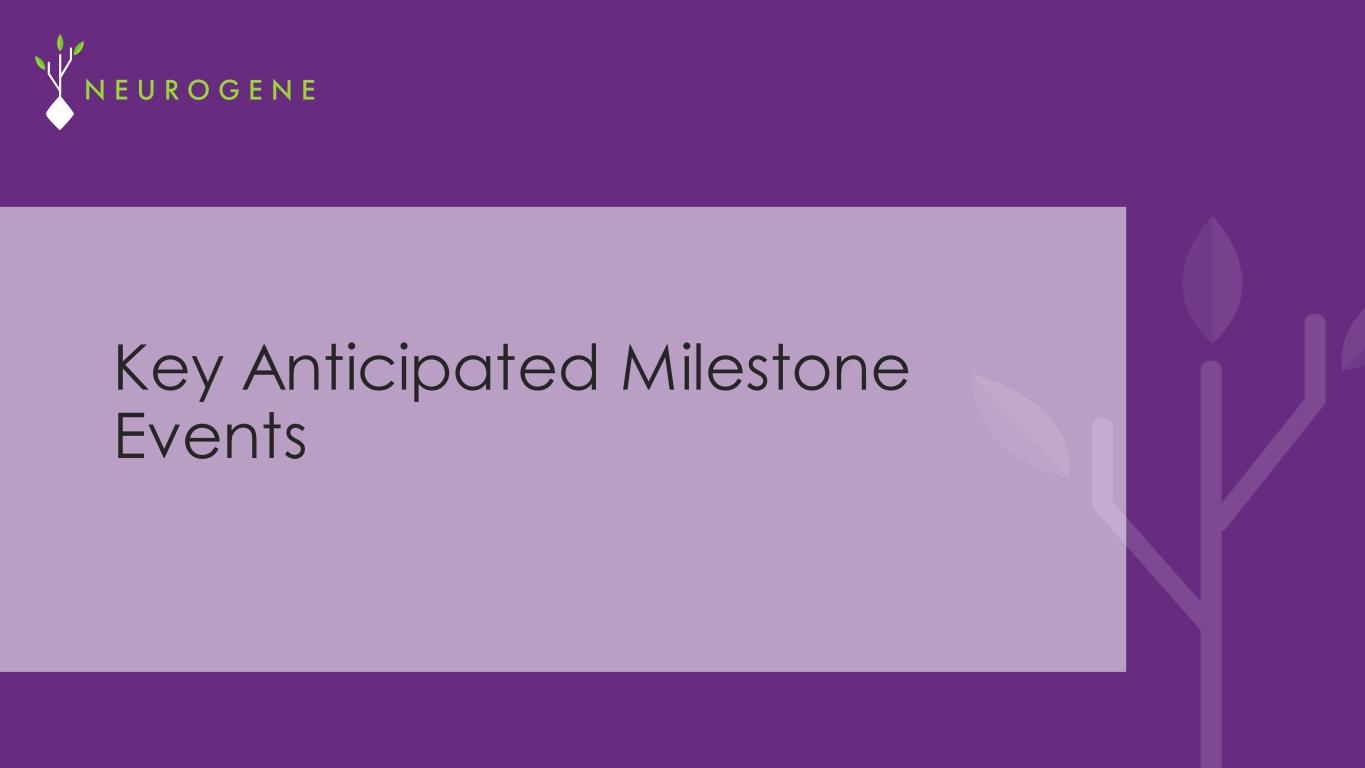
Key Anticipated Milestone Events
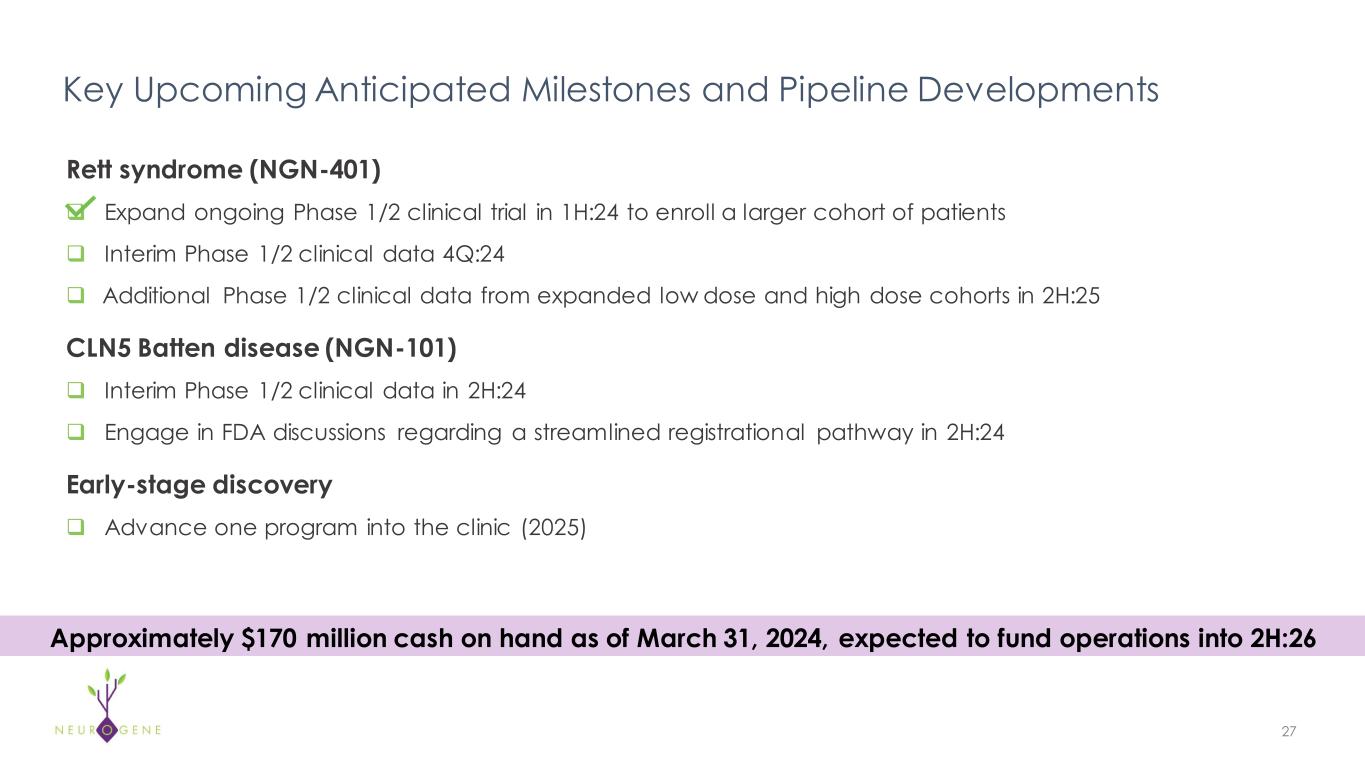
Key Upcoming Anticipated Milestones and Pipeline Developments Rett syndrome (NGN-401) ❑ Expand ongoing Phase 1/2 clinical trial in 1H:24 to enroll a larger cohort of patients ❑ Interim Phase 1/2 clinical data 4Q:24 ❑ Additional Phase 1/2 clinical data from expanded low dose and high dose cohorts in 2H:25 CLN5 Batten disease (NGN-101) ❑ Interim Phase 1/2 clinical data in 2H:24 ❑ Engage in FDA discussions regarding a streamlined registrational pathway in 2H:24 Early-stage discovery ❑ Advance one program into the clinic (2025) 27 Approximately $170 million cash on hand as of March 31, 2024, expected to fund operations into 2H:26
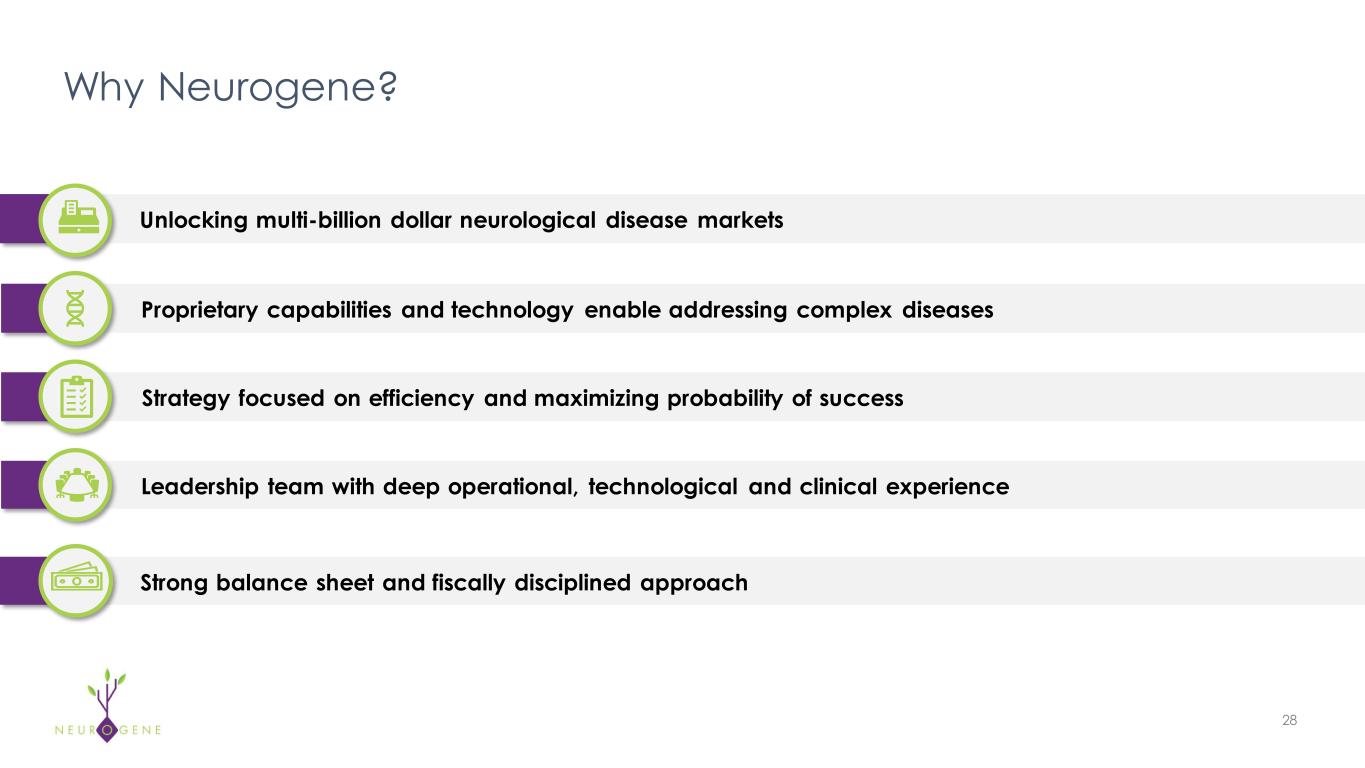
28 Why Neurogene? Unlocking multi-billion dollar neurological disease markets Proprietary capabilities and technology enable addressing complex diseases Strategy focused on efficiency and maximizing probability of success Leadership team with deep operational, technological and clinical experience Strong balance sheet and fiscally disciplined approach
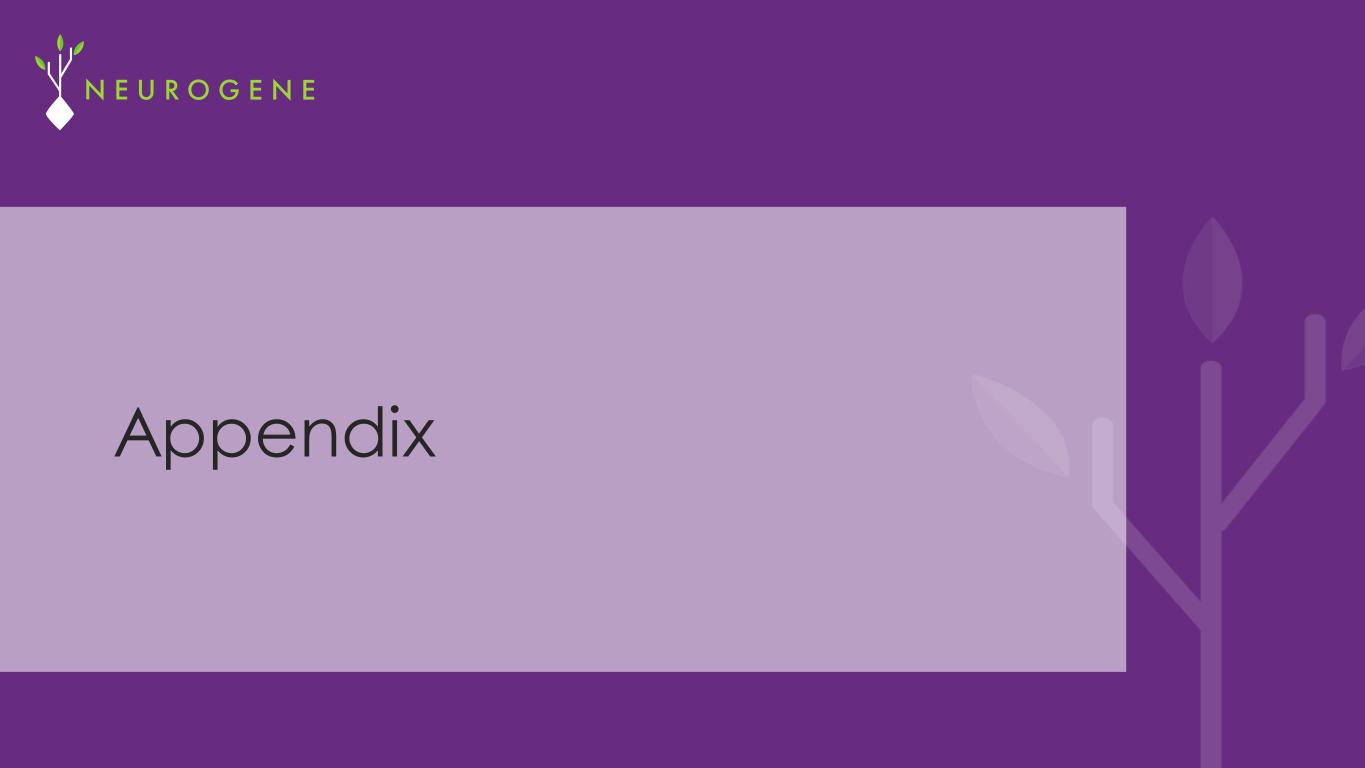
Appendix
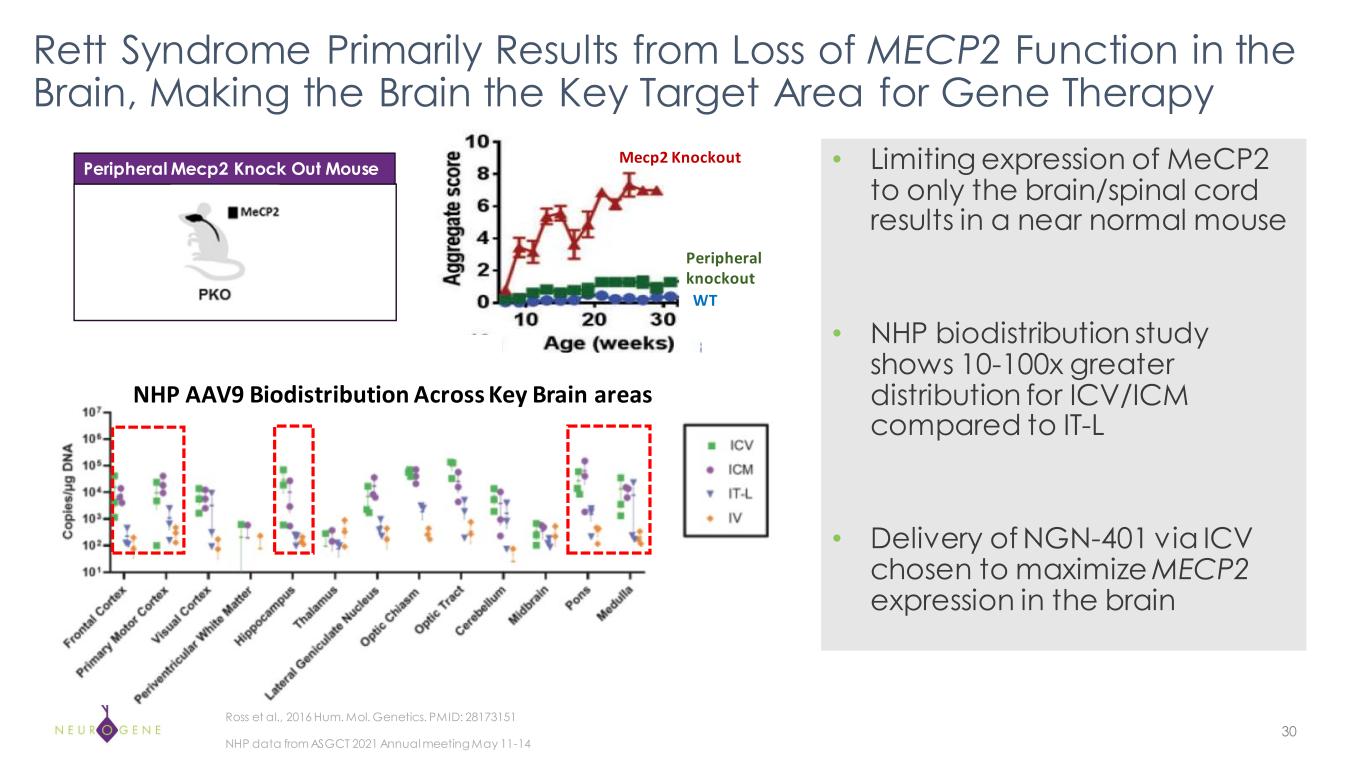
Rett Syndrome Primarily Results from Loss of MECP2 Function in the Brain, Making the Brain the Key Target Area for Gene Therapy • Limiting expression of MeCP2 to only the brain/spinal cord results in a near normal mouse • NHP biodistribution study shows 10-100x greater distribution for ICV/ICM compared to IT-L • Delivery of NGN-401 via ICV chosen to maximize MECP2 expression in the brain 30 Ross et al., 2016 Hum. Mol. Genetics. PMID: 28173151 NHP data from ASGCT 2021 Annual meeting May 11-14 Peripheral Mecp2 Knock Out Mouse NHP AAV9 Biodistribution Across Key Brain areas Mecp2 Knockout Peripheral knockout WT
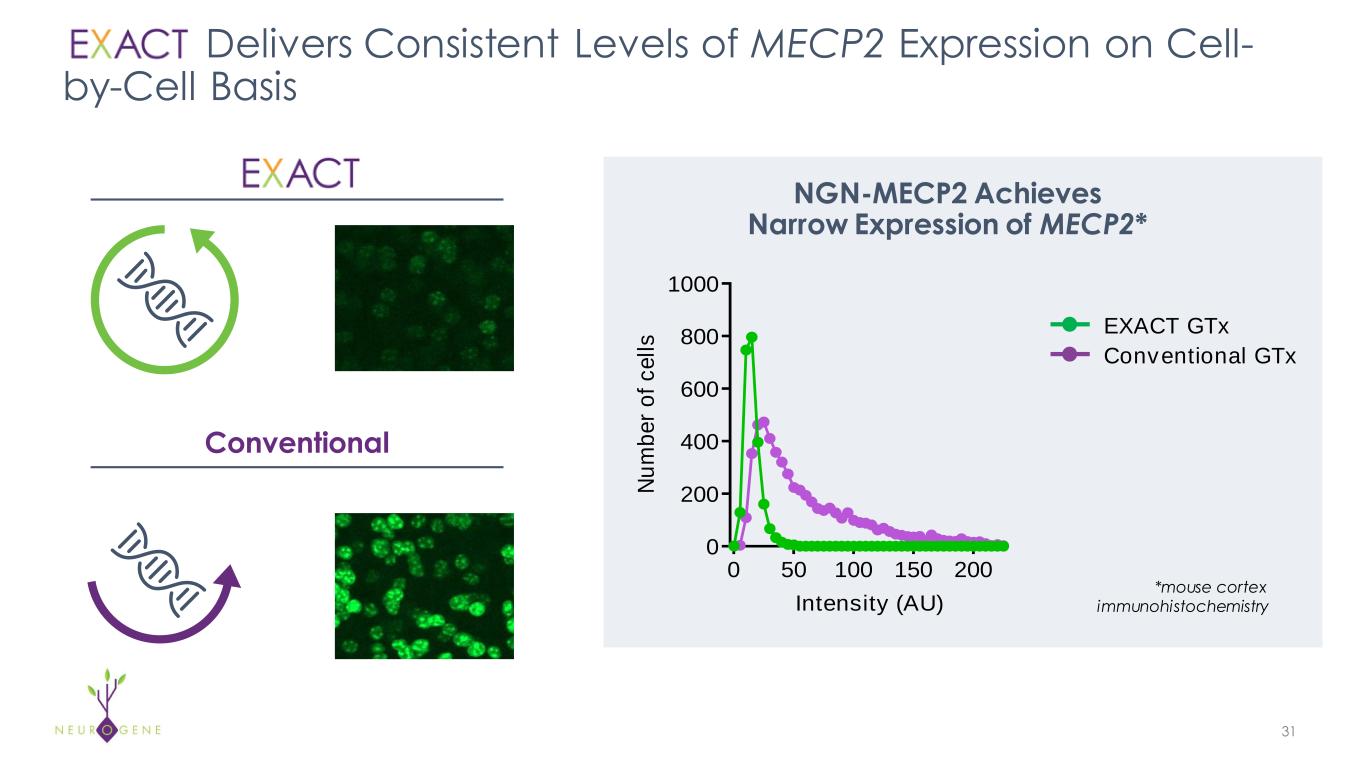
Delivers Consistent Levels of MECP2 Expression on Cell- by-Cell Basis 31 Conventional NGN-MECP2 Achieves Narrow Expression of MECP2* 0 50 100 150 200 0 200 400 600 800 1000 Intensity (AU) N u m b e r o f c e ll s Unregulated Regulated EXACT GTx Conventional GTx *mouse cortex immunohistochemistry
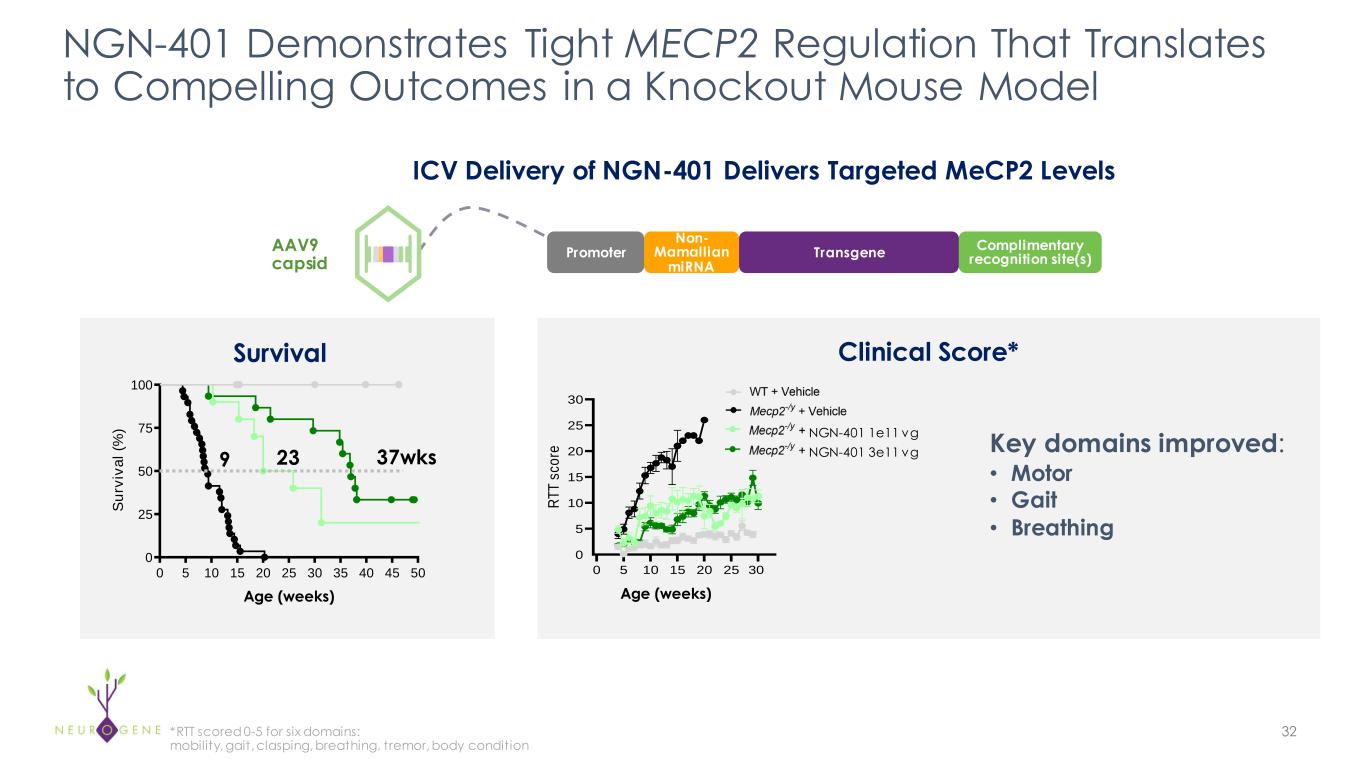
NGN-401 Demonstrates Tight MECP2 Regulation That Translates to Compelling Outcomes in a Knockout Mouse Model 32 0 5 10 15 20 25 30 35 40 45 50 0 25 50 75 100 S u rv iv a l (% ) Survival 9 23 37wks Age (weeks) *RTT scored 0-5 for six domains: mobility, gait, clasping, breathing, tremor, body condition 0 5 10 15 20 25 30 0 5 10 15 20 25 30 R T T s co re Clinical Score* NGN-401 1e11 vg NGN-401 3e11 vg Age (weeks) Key domains improved: • Motor • Gait • Breathing ICV Delivery of NGN-401 Delivers Targeted MeCP2 Levels AAV9 capsid Non- Mamallian miRNA Transgene Complimentary recognition site(s)Promoter
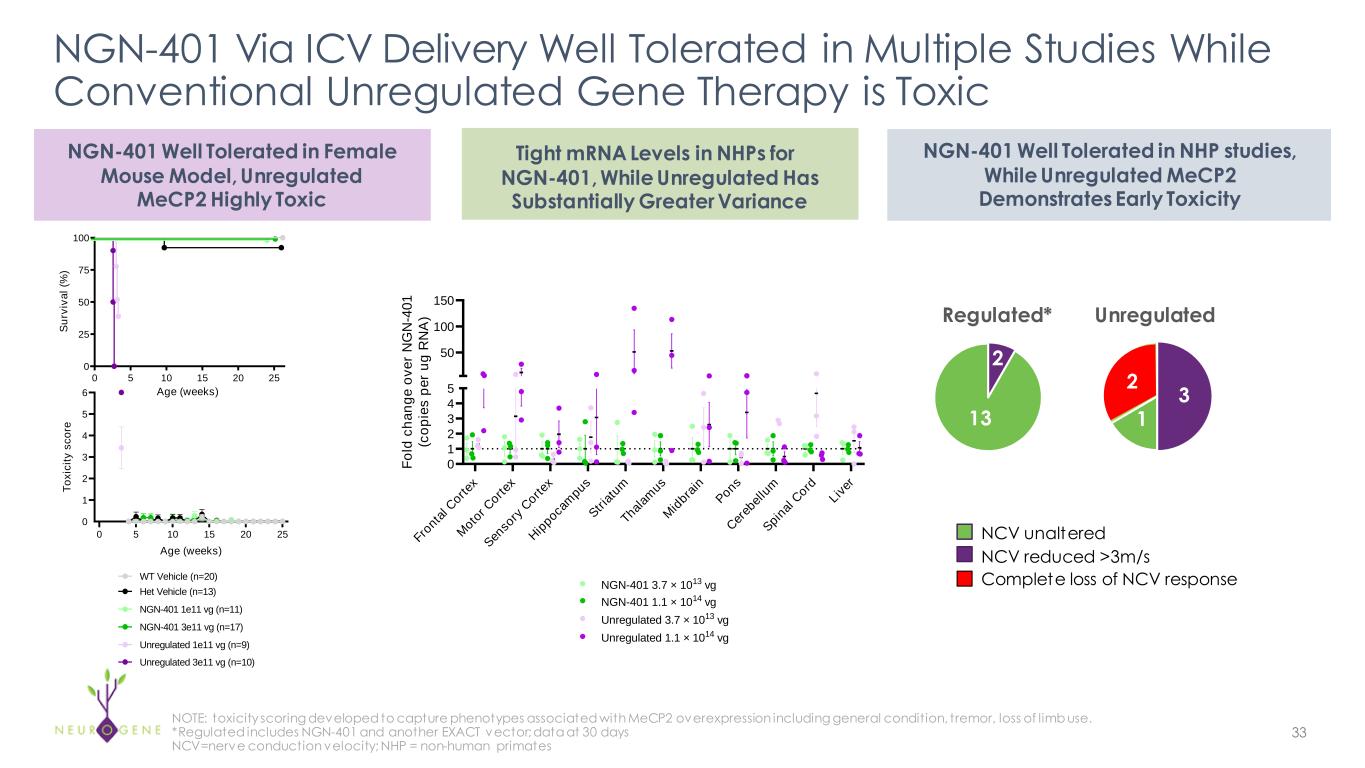
NGN-401 low dose NGN-401 high dose AAV9-RTT251 low dose AAV9-RTT251 high dose NGN-401 Via ICV Delivery Well Tolerated in Multiple Studies While Conventional Unregulated Gene Therapy is Toxic 33 NOTE: toxicity scoring developed to capture phenotypes associated with MeCP2 overexpression including general condition, tremor, loss of limb use. *Regulated includes NGN-401 and another EXACT vector; data at 30 days NCV=nerve conduction velocity; NHP = non-human primates NGN-401 Well Tolerated in Female Mouse Model, Unregulated MeCP2 Highly Toxic NGN-401 Well Tolerated in NHP studies, While Unregulated MeCP2 Demonstrates Early Toxicity Tight mRNA Levels in NHPs for NGN-401, While Unregulated Has Substantially Greater Variance NCV unaltered NCV reduced >3m/s Complete loss of NCV response Unregulated 3 2 1 Regulated* 13 2 0 5 10 15 20 25 0 1 2 3 4 5 6 Age (weeks) T o x ic it y s c o re WT Vehicle (n=20) Het Vehicle (n=13) NGN-401 1e11 vg (n=11) NGN-401 3e11 vg (n=17) Unregulated 1e11 vg (n=9) Unregulated 3e11 vg (n=10) 0 5 10 15 20 25 0 25 50 75 100 Age (weeks) S u rv iv a l (% ) Fro nta l C ort ex M oto r C ort ex S en so ry C ort ex H ip poca m pus S tr ia tu m Thal am us M id bra in P ons C er eb el lu m S pin al C ord Liv er 0 1 2 3 4 5 50 100 150 F o ld c h a n g e o v e r N G N -4 0 1 (c o p ie s p e r u g R N A ) NGN-401 3.7 × 1013 vg NGN-401 1.1 × 1014 vg Unregulated 3.7 × 1013 vg Unregulated 1.1 × 1014 vg
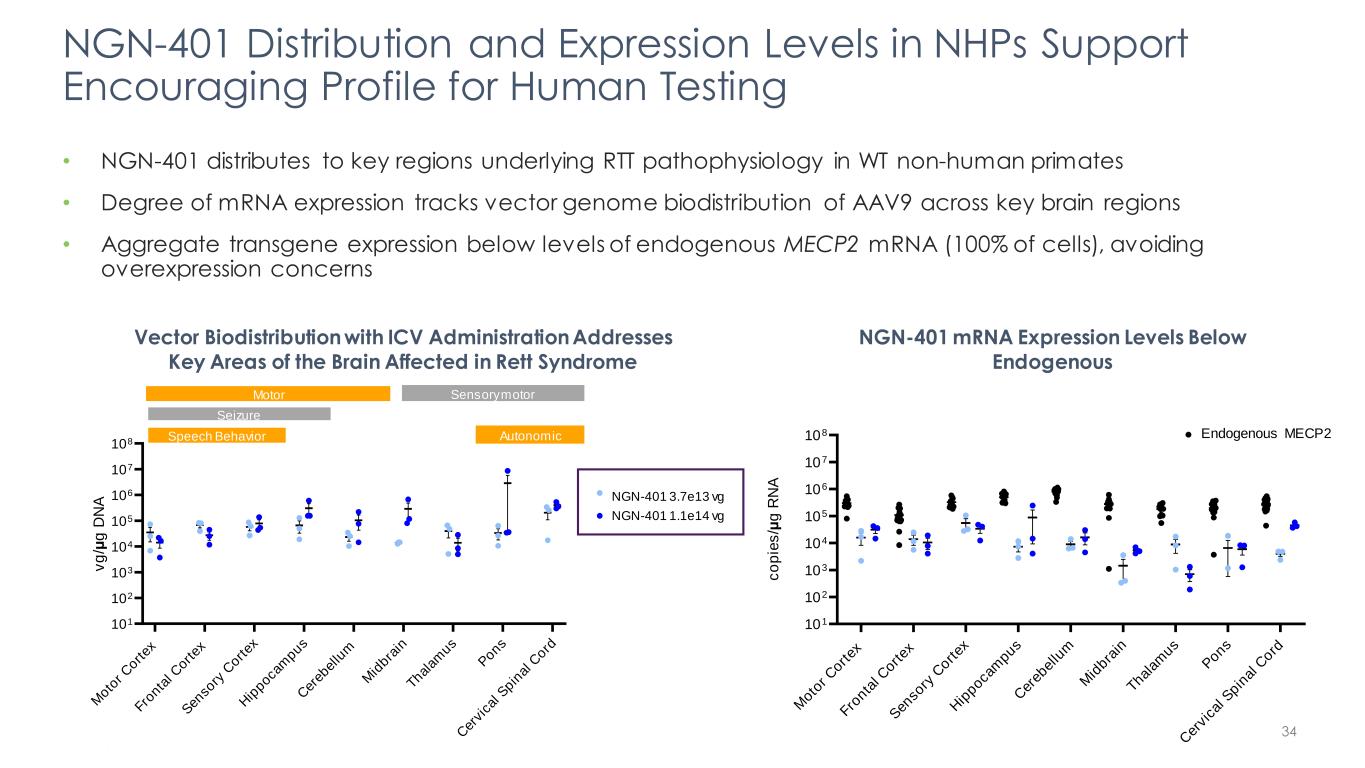
NGN-401 Distribution and Expression Levels in NHPs Support Encouraging Profile for Human Testing 34 • NGN-401 distributes to key regions underlying RTT pathophysiology in WT non-human primates • Degree of mRNA expression tracks vector genome biodistribution of AAV9 across key brain regions • Aggregate transgene expression below levels of endogenous MECP2 mRNA (100% of cells), avoiding overexpression concerns M oto r C ort ex Fro nta l C ort ex Sen so ry C ort ex H ip poca m pus C er eb el lu m M id bra in Thal am us P ons C er vi ca l S pin al C ord 101 102 103 104 105 106 107 108 v g /μ g D N A NGN-401 low dose NGN-401 high dose Seizure Speech Behavior Motor Sensory motor Autonomic Vector biodistribution NGN-401 mRNA Expression Levels Below Endogenous Vector Biodistribution with ICV Administration Addresses Key Areas of the Brain Affected in Rett Syndrome Endogenous MECP2 NGN-401 3.7e13 vg NGN-401 1.1e14 vg M oto r C ort ex Fro nta l C ort ex S en so ry C ort ex H ip poca m pus C er eb el lu m M id bra in Thal am us P ons C er vi ca l S pin al C ord 101 102 103 104 105 106 107 108 c o p ie s /μ g R N A
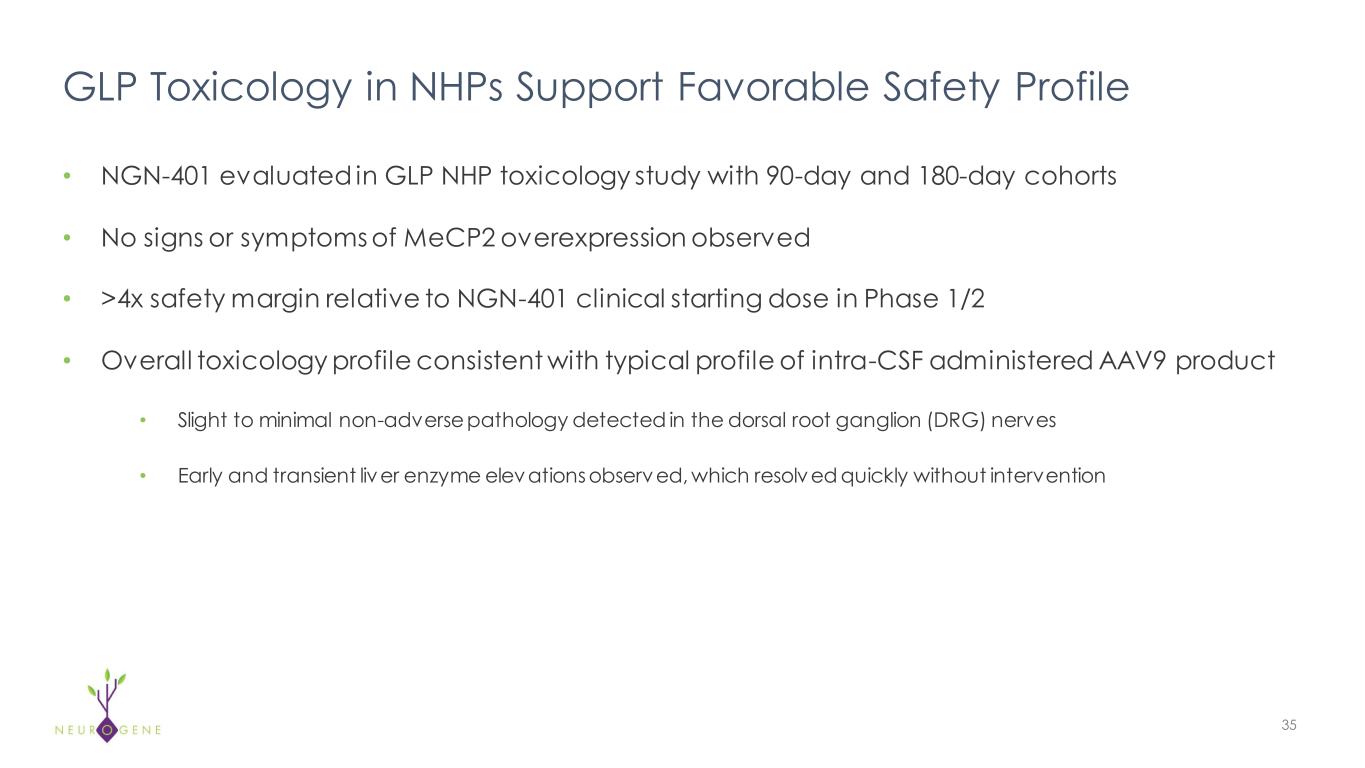
GLP Toxicology in NHPs Support Favorable Safety Profile 35 • NGN-401 evaluated in GLP NHP toxicology study with 90-day and 180-day cohorts • No signs or symptoms of MeCP2 overexpression observed • >4x safety margin relative to NGN-401 clinical starting dose in Phase 1/2 • Overall toxicology profile consistent with typical profile of intra-CSF administered AAV9 product • Slight to minimal non-adverse pathology detected in the dorsal root ganglion (DRG) nerves • Early and transient liver enzyme elevations observed, which resolved quickly without intervention
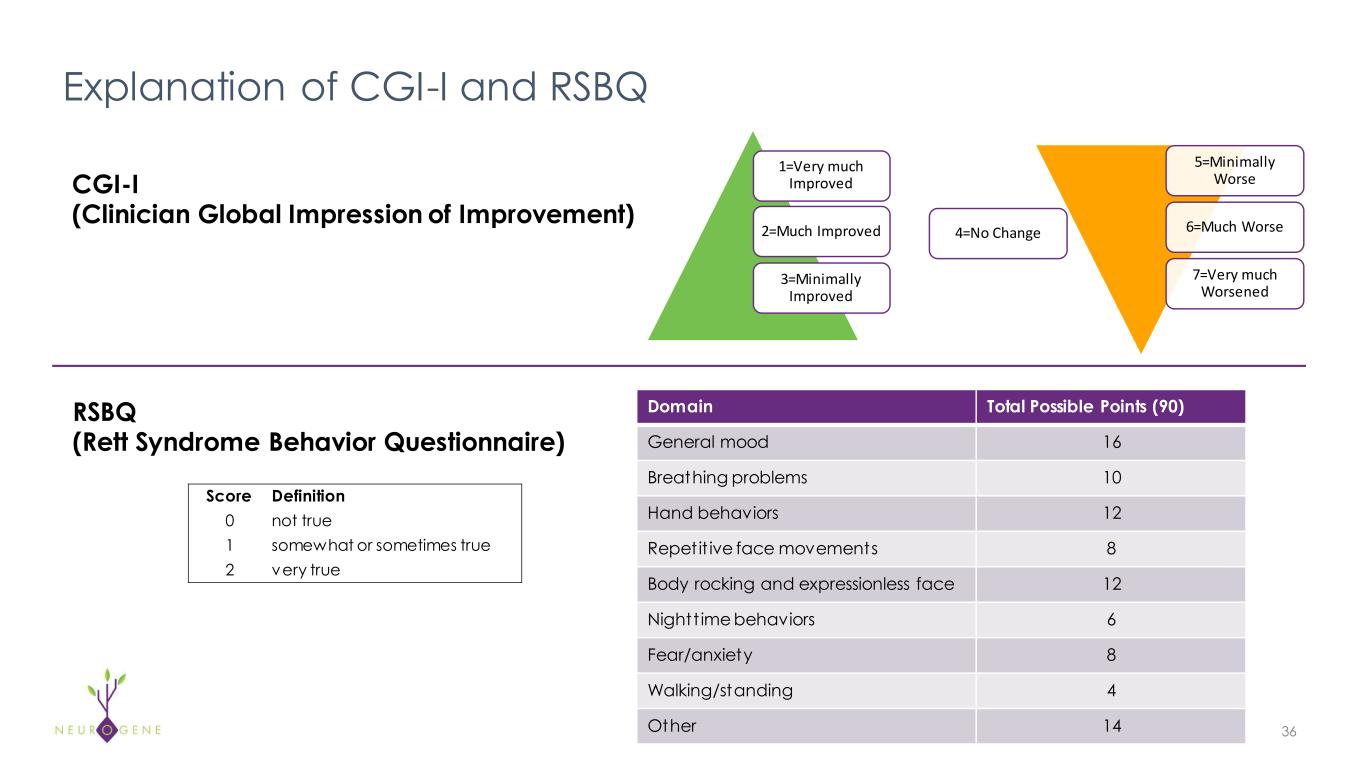
Explanation of CGI-I and RSBQ 36 CGI-I (Clinician Global Impression of Improvement) 1=Very much Improved 2=Much Improved 3=Minimally Improved 7=Very much Worsened 6=Much Worse 5=Minimally Worse RSBQ (Rett Syndrome Behavior Questionnaire) 4=No Change Domain Total Possible Points (90) General mood 16 Breathing problems 10 Hand behaviors 12 Repetit ive face movements 8 Body rocking and expressionless face 12 Nightt ime behaviors 6 Fear/anxiety 8 Walking/standing 4 Other 14 Score Definition 0 not true 1 somewhat or sometimes true 2 very true
v3.24.1.1.u2
| X |
- DefinitionBoolean flag that is true when the XBRL content amends previously-filed or accepted submission.
| Name: |
dei_AmendmentFlag |
| Namespace Prefix: |
dei_ |
| Data Type: |
xbrli:booleanItemType |
| Balance Type: |
na |
| Period Type: |
duration |
|
| X |
- DefinitionFor the EDGAR submission types of Form 8-K: the date of the report, the date of the earliest event reported; for the EDGAR submission types of Form N-1A: the filing date; for all other submission types: the end of the reporting or transition period. The format of the date is YYYY-MM-DD.
| Name: |
dei_DocumentPeriodEndDate |
| Namespace Prefix: |
dei_ |
| Data Type: |
xbrli:dateItemType |
| Balance Type: |
na |
| Period Type: |
duration |
|
| X |
- DefinitionThe type of document being provided (such as 10-K, 10-Q, 485BPOS, etc). The document type is limited to the same value as the supporting SEC submission type, or the word 'Other'.
| Name: |
dei_DocumentType |
| Namespace Prefix: |
dei_ |
| Data Type: |
dei:submissionTypeItemType |
| Balance Type: |
na |
| Period Type: |
duration |
|
| X |
- DefinitionAddress Line 1 such as Attn, Building Name, Street Name
| Name: |
dei_EntityAddressAddressLine1 |
| Namespace Prefix: |
dei_ |
| Data Type: |
xbrli:normalizedStringItemType |
| Balance Type: |
na |
| Period Type: |
duration |
|
| X |
- DefinitionAddress Line 2 such as Street or Suite number
| Name: |
dei_EntityAddressAddressLine2 |
| Namespace Prefix: |
dei_ |
| Data Type: |
xbrli:normalizedStringItemType |
| Balance Type: |
na |
| Period Type: |
duration |
|
| X |
- Definition
+ References
+ Details
| Name: |
dei_EntityAddressCityOrTown |
| Namespace Prefix: |
dei_ |
| Data Type: |
xbrli:normalizedStringItemType |
| Balance Type: |
na |
| Period Type: |
duration |
|
| X |
- DefinitionCode for the postal or zip code
| Name: |
dei_EntityAddressPostalZipCode |
| Namespace Prefix: |
dei_ |
| Data Type: |
xbrli:normalizedStringItemType |
| Balance Type: |
na |
| Period Type: |
duration |
|
| X |
- DefinitionName of the state or province.
| Name: |
dei_EntityAddressStateOrProvince |
| Namespace Prefix: |
dei_ |
| Data Type: |
dei:stateOrProvinceItemType |
| Balance Type: |
na |
| Period Type: |
duration |
|
| X |
- DefinitionA unique 10-digit SEC-issued value to identify entities that have filed disclosures with the SEC. It is commonly abbreviated as CIK. Reference 1: http://www.xbrl.org/2003/role/presentationRef
-Publisher SEC
-Name Exchange Act
-Number 240
-Section 12
-Subsection b-2
| Name: |
dei_EntityCentralIndexKey |
| Namespace Prefix: |
dei_ |
| Data Type: |
dei:centralIndexKeyItemType |
| Balance Type: |
na |
| Period Type: |
duration |
|
| X |
- DefinitionIndicate if registrant meets the emerging growth company criteria. Reference 1: http://www.xbrl.org/2003/role/presentationRef
-Publisher SEC
-Name Exchange Act
-Number 240
-Section 12
-Subsection b-2
| Name: |
dei_EntityEmergingGrowthCompany |
| Namespace Prefix: |
dei_ |
| Data Type: |
xbrli:booleanItemType |
| Balance Type: |
na |
| Period Type: |
duration |
|
| X |
- DefinitionCommission file number. The field allows up to 17 characters. The prefix may contain 1-3 digits, the sequence number may contain 1-8 digits, the optional suffix may contain 1-4 characters, and the fields are separated with a hyphen.
| Name: |
dei_EntityFileNumber |
| Namespace Prefix: |
dei_ |
| Data Type: |
dei:fileNumberItemType |
| Balance Type: |
na |
| Period Type: |
duration |
|
| X |
- DefinitionTwo-character EDGAR code representing the state or country of incorporation.
| Name: |
dei_EntityIncorporationStateCountryCode |
| Namespace Prefix: |
dei_ |
| Data Type: |
dei:edgarStateCountryItemType |
| Balance Type: |
na |
| Period Type: |
duration |
|
| X |
- DefinitionThe exact name of the entity filing the report as specified in its charter, which is required by forms filed with the SEC. Reference 1: http://www.xbrl.org/2003/role/presentationRef
-Publisher SEC
-Name Exchange Act
-Number 240
-Section 12
-Subsection b-2
| Name: |
dei_EntityRegistrantName |
| Namespace Prefix: |
dei_ |
| Data Type: |
xbrli:normalizedStringItemType |
| Balance Type: |
na |
| Period Type: |
duration |
|
| X |
- DefinitionThe Tax Identification Number (TIN), also known as an Employer Identification Number (EIN), is a unique 9-digit value assigned by the IRS. Reference 1: http://www.xbrl.org/2003/role/presentationRef
-Publisher SEC
-Name Exchange Act
-Number 240
-Section 12
-Subsection b-2
| Name: |
dei_EntityTaxIdentificationNumber |
| Namespace Prefix: |
dei_ |
| Data Type: |
dei:employerIdItemType |
| Balance Type: |
na |
| Period Type: |
duration |
|
| X |
- DefinitionLocal phone number for entity.
| Name: |
dei_LocalPhoneNumber |
| Namespace Prefix: |
dei_ |
| Data Type: |
xbrli:normalizedStringItemType |
| Balance Type: |
na |
| Period Type: |
duration |
|
| X |
- DefinitionBoolean flag that is true when the Form 8-K filing is intended to satisfy the filing obligation of the registrant as pre-commencement communications pursuant to Rule 13e-4(c) under the Exchange Act. Reference 1: http://www.xbrl.org/2003/role/presentationRef
-Publisher SEC
-Name Exchange Act
-Number 240
-Section 13e
-Subsection 4c
| Name: |
dei_PreCommencementIssuerTenderOffer |
| Namespace Prefix: |
dei_ |
| Data Type: |
xbrli:booleanItemType |
| Balance Type: |
na |
| Period Type: |
duration |
|
| X |
- DefinitionBoolean flag that is true when the Form 8-K filing is intended to satisfy the filing obligation of the registrant as pre-commencement communications pursuant to Rule 14d-2(b) under the Exchange Act. Reference 1: http://www.xbrl.org/2003/role/presentationRef
-Publisher SEC
-Name Exchange Act
-Number 240
-Section 14d
-Subsection 2b
| Name: |
dei_PreCommencementTenderOffer |
| Namespace Prefix: |
dei_ |
| Data Type: |
xbrli:booleanItemType |
| Balance Type: |
na |
| Period Type: |
duration |
|
| X |
- DefinitionTitle of a 12(b) registered security. Reference 1: http://www.xbrl.org/2003/role/presentationRef
-Publisher SEC
-Name Exchange Act
-Number 240
-Section 12
-Subsection b
| Name: |
dei_Security12bTitle |
| Namespace Prefix: |
dei_ |
| Data Type: |
dei:securityTitleItemType |
| Balance Type: |
na |
| Period Type: |
duration |
|
| X |
- DefinitionName of the Exchange on which a security is registered. Reference 1: http://www.xbrl.org/2003/role/presentationRef
-Publisher SEC
-Name Exchange Act
-Number 240
-Section 12
-Subsection d1-1
| Name: |
dei_SecurityExchangeName |
| Namespace Prefix: |
dei_ |
| Data Type: |
dei:edgarExchangeCodeItemType |
| Balance Type: |
na |
| Period Type: |
duration |
|
| X |
- DefinitionBoolean flag that is true when the Form 8-K filing is intended to satisfy the filing obligation of the registrant as soliciting material pursuant to Rule 14a-12 under the Exchange Act. Reference 1: http://www.xbrl.org/2003/role/presentationRef
-Publisher SEC
-Name Exchange Act
-Section 14a
-Number 240
-Subsection 12
| Name: |
dei_SolicitingMaterial |
| Namespace Prefix: |
dei_ |
| Data Type: |
xbrli:booleanItemType |
| Balance Type: |
na |
| Period Type: |
duration |
|
| X |
- DefinitionTrading symbol of an instrument as listed on an exchange.
| Name: |
dei_TradingSymbol |
| Namespace Prefix: |
dei_ |
| Data Type: |
dei:tradingSymbolItemType |
| Balance Type: |
na |
| Period Type: |
duration |
|
| X |
- DefinitionBoolean flag that is true when the Form 8-K filing is intended to satisfy the filing obligation of the registrant as written communications pursuant to Rule 425 under the Securities Act. Reference 1: http://www.xbrl.org/2003/role/presentationRef
-Publisher SEC
-Name Securities Act
-Number 230
-Section 425
| Name: |
dei_WrittenCommunications |
| Namespace Prefix: |
dei_ |
| Data Type: |
xbrli:booleanItemType |
| Balance Type: |
na |
| Period Type: |
duration |
|
Neoleukin Therapeutics (NASDAQ:NLTX)
Historical Stock Chart
From Apr 2024 to May 2024
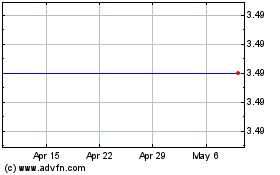
Neoleukin Therapeutics (NASDAQ:NLTX)
Historical Stock Chart
From May 2023 to May 2024
